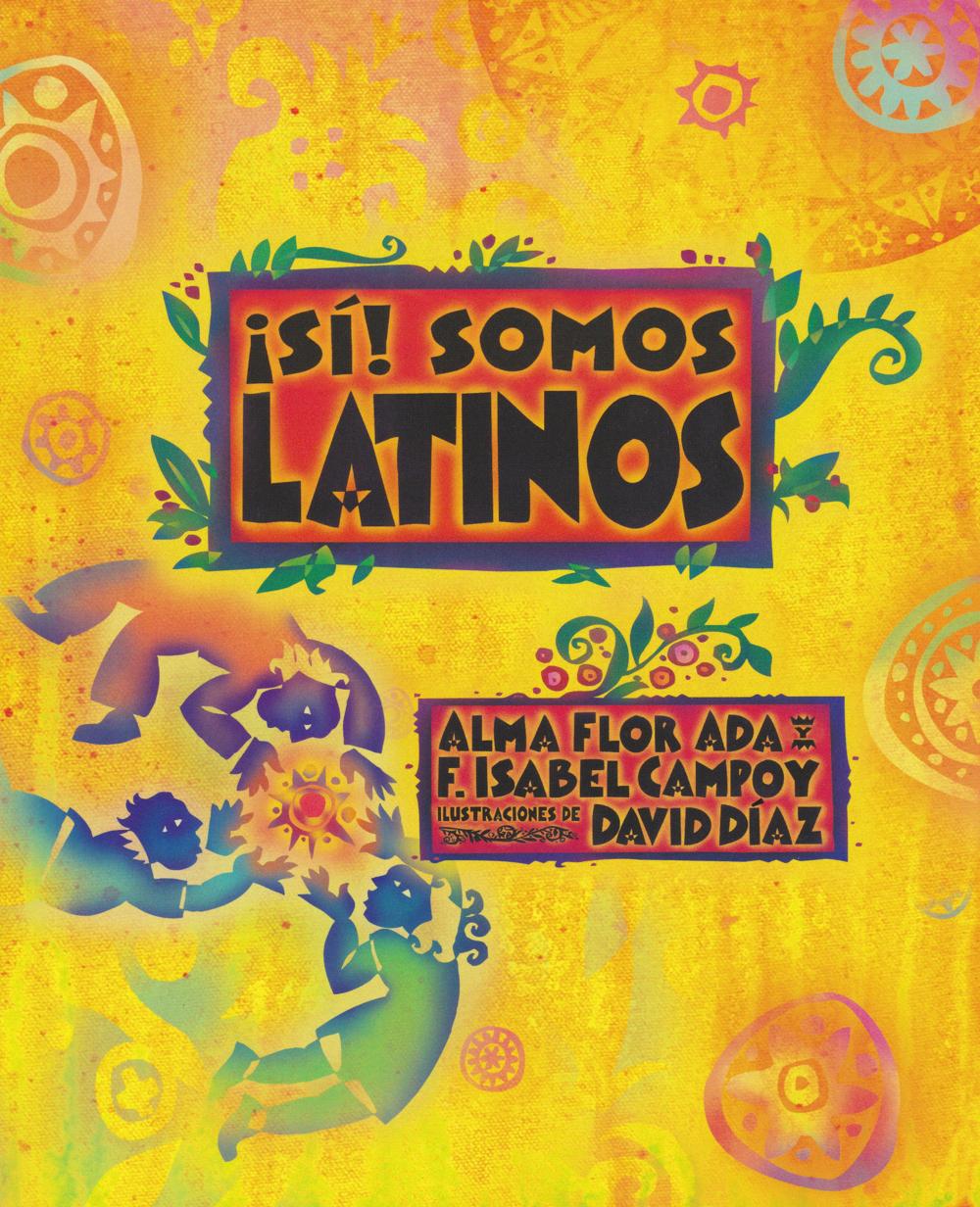 Story
Collection Pink
Story
Collection Pink Story
Collection Pink
Story
Collection Pink
To Order or to Ask a Del Sol
Question,
read the Del Sol Order
Info and then email Rey Del Sol
![]()
Story
Collection Pink Books and CDs Spanish Set
$141.35,
Including 20%-Off, Free Immediate Mailing, and No Sales Tax
10 Books and 2 CDs : 9 Softcover
Spanish Books, and 2 Spanish Storytelling CDs
Clave de sol,
Softcover, Spanish, Book, Alma
Flor Ada, Teacher, 9781598205084, $19.95
Con
carina Amalia, Softcover, Spanish, Book, Alma Flor
Ada,, Gabriel Zubizarreta, 3rd Grade and Up, 9781442424067, $6.99
Cuentos que contaban nuestras abuelas, Softcover, Spanish, Book, Alma
Flor Ada and F.
Isabel Campoy, Felipe Davalos, Susan Guevara, and Leyla Torres, Felipe
Davalos, 3rd Grade and Up, 9781416939658,
$12.99
Cuentos que contaban nuestras abuelas,
Spanish, 2 Storytelling CDs, Alma
Flor Ada and F.
Isabel Campoy,
3rd Grade and Up, $29.95 Listen
Destellos
y sombras, Softcover, Spanish, Book, Suni Paz,
3rd Grade and Up,
9781424332687, $19.95
Encaje
de piedra, Softcover, Spanish, Book, Alma
Flor Ada, Kitty Lorefice de Passalia, 3rd Grade and Up, 9789505003556,
$19.95
Me
llamo Maria Isabel, Softcover, Spanish, Book, Alma
Flor Ada, K. Dyble Thompson, 2nd Grade and Up, 9780689810992, $5.99
Nacer
bailando, Softcover, Spanish, Book, Alma Flor Ada,
Gabriel Zubizarreta, 3rd Grade and Up, 9781442481763, $6.99 Watch
Watch
Si
somos
Latinos, Softcover, Spanish, Book,
Alma
Flor Ada and F.
Isabel Campoy, Leslie Tryon, 3rd Grade and Up, 9781622637447, $14.95
Tesoros de mi isla, Softcover, Spanish, Book, Alma
Flor Ada, 3rd Grade and Up, 9781631137457, $18.99
Vivir
en dos idiomas, Softcover, Spanish, Book, Alma
Flor Ada, 3rd Grade and Up,
9781603966115, $19.99
Story
Collection Pink Books English Set
$62.25, Including 20%-Off, Free Immediate Mailing, and No Sales Tax
7 Books : 1 Hardcover English
Books and 6 Softcover English Books
Dancing Home,
Softcover, English, Book, Alma Flor Ada,
Gabriel Zubizarreta, 3rd Grade and Up, 9781442481756, $7.99 Watch
Watch
Island
Treasures, Softcover, English, Book, Alma Flor Ada,
3rd Grade and Up, 9781481429009, $7.99
Love
Amalia, Softcover, English, Book, Alma Flor Ada,
Gabriel Zubizarreta, 3rd Grade and Up, 9781442424036, $5.99
My Name is Maria
Isabel, Softcover, English, Book, Alma
Flor Ada, 2nd Grade and Up, 9780689802171,
$5.99 Watch
Sparkles and Shadows,
Softcover, English, Book, Suni Paz,
3rd Grade and Up,
9781424332687, $19.95 Listen
Tales Our
Abuelitas Told, Hardcover, English,
Book, Alma
Flor Ada and F.
Isabel Campoy, Felipe Davalos, Susan Guevara, and Leyla Torres, Felipe
Davalos, 3rd Grade and Up, 9780689825835, $19.95 Watch
Yes
We are Latinos, Softcover, English, Book, Alma
Flor Ada and F.
Isabel Campoy, Leslie Tryon, 3rd Grade and Up, 9781580895491, $9.95
Additional Book Formats
Con
Carina Amalia, Hardcover, Spanish, Book, Alma Flor Ada,
Gabriel Zubizarreta, 3rd Grade and Up, 9781442424050, $15.99
Dancing Home,
Hardcover, English, Book, Alma Flor Ada,
Gabriel Zubizarreta, 3rd Grade and Up, 9781416900887, $15.99 Watch
Watch
Island
Treasures, Hardcover, English, Book, Alma Flor Ada,
3rd Grade and Up, 9781481442459, $18.99
Love
Amalia, Hardcover, English, Book, Alma Flor Ada,
Gabriel Zubizarreta, 3rd Grade and Up, 9781442424029, $15.99
My Name is Maria Isabel,
Hardcover, English, Book, Alma
Flor Ada, K. Dyble Thompson, 2nd Grade and Up,
9780689315176, $17.95 Watch
Nacer
Bailando, Hardcover, Spanish, Book, Alma Flor Ada,
Gabriel Zubizarreta, 3rd Grade and Up, 9781442420618, $15.99 Watch
Watch
Under the Royal Palms, Hardcover,
English, Book,
Alma
Flor Ada, 3rd
Grade and Up, 9780689806315, $17.99 Watch
Listen
Listen
Where
the Flame Trees Bloom, Softcover, English, Book, Alma
Flor Ada, 3rd Grade and up, 9781416968405, $9.95 Watch
Yes We are
Latinos,
Hardcover, English, Book,
Alma
Flor Ada and F.
Isabel Campoy, Leslie Tryon, 3rd Grade and Up,
9781580893831, $18.95
If you want to
choose individual titles instead of entire sets, then feel free to do so at the
same 20%-Off, with Free Immediate Mailing and No Sales Tax. Email
Rey Del Sol
If you need to buy
in quantity, then feel free to request almost any US Book at the
same 20%-Off, with Free Mailing and No Sales Tax. Email
Rey Del Sol
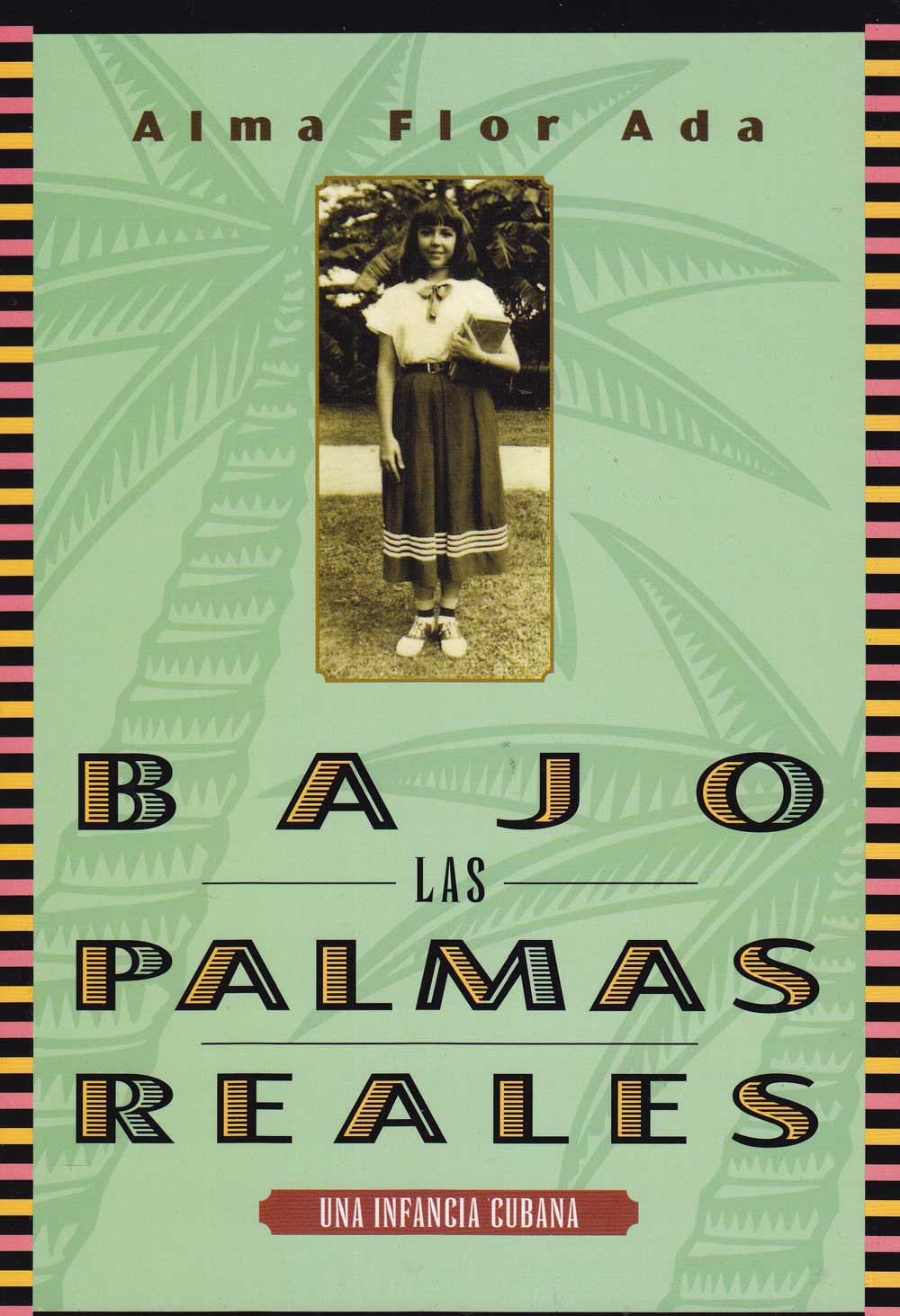 Bajo
las palmas reales
Bajo
las palmas reales
Under the Royal Palms
Under the Royal Palms
is also included in Island Treasures, along with Where the Flame Trees
Bloom
Pura Belpre Award
Winning Book in 2000 for Narrative
American Library Association, Best Books of the Year 2000
Center for Latin American Studies, America´s Commended List
National Council of Teachers of English, Notable Book in the Area of Language
Arts
Video : Colorin
Colorado Interview, Spanish
Video : Colorin
Colorado Interview, English
In this companion volume to Alma Flor Ada's "Where the Flame Trees Bloom", the author offers young readers another inspiring collection of stories and reminiscences drawn from her childhood on the island of Cuba. Through those stories we see how the many events and relationships she enjoyed helped shape who she is today. We learn of a deep friendship with a beloved dance teacher that helped sustain young Alma Flor through a miserable year in school. We meet relatives, like her mysterious Uncle Manolo, whose secret, she later learns, is that he dedicated his life to healing lepers. We share the tragedy of another uncle whose spirited personality leads to his love of flying...and the crash that takes his life. Heartwarming, poignant, and often humorous, this collection encourages children to discover the stories in their our own lives -- stories that can help inform their own values and celebrate the joys and struggles we all share no matter where or when we grew up.
The Pura Belpré Award honors Latino writers and illustrators whose work best portrays, affirms and celebrates the Latino cultural experience in a children's book. Alma Flor Ada was named the winner of the Belpré Author Award for Under the Royal Palms: A Childhood in Cuba, published by Atheneum Books. The award was announced January 17, 2000 during the American Library Association (ALA) Midwinter Meeting in San Antonio. The award is administered by the Association for Library Service to Children (ALSC), a division of ALA, and REFORMA, the National Association to Promote Library Services to the Spanish Speaking.
Listen to Vienna Rose read Under the Royal Palms to you. A marvelous example of the magical encounter between a child and books that we wish for all children. And here's an earlier reading by Vienna Rose.
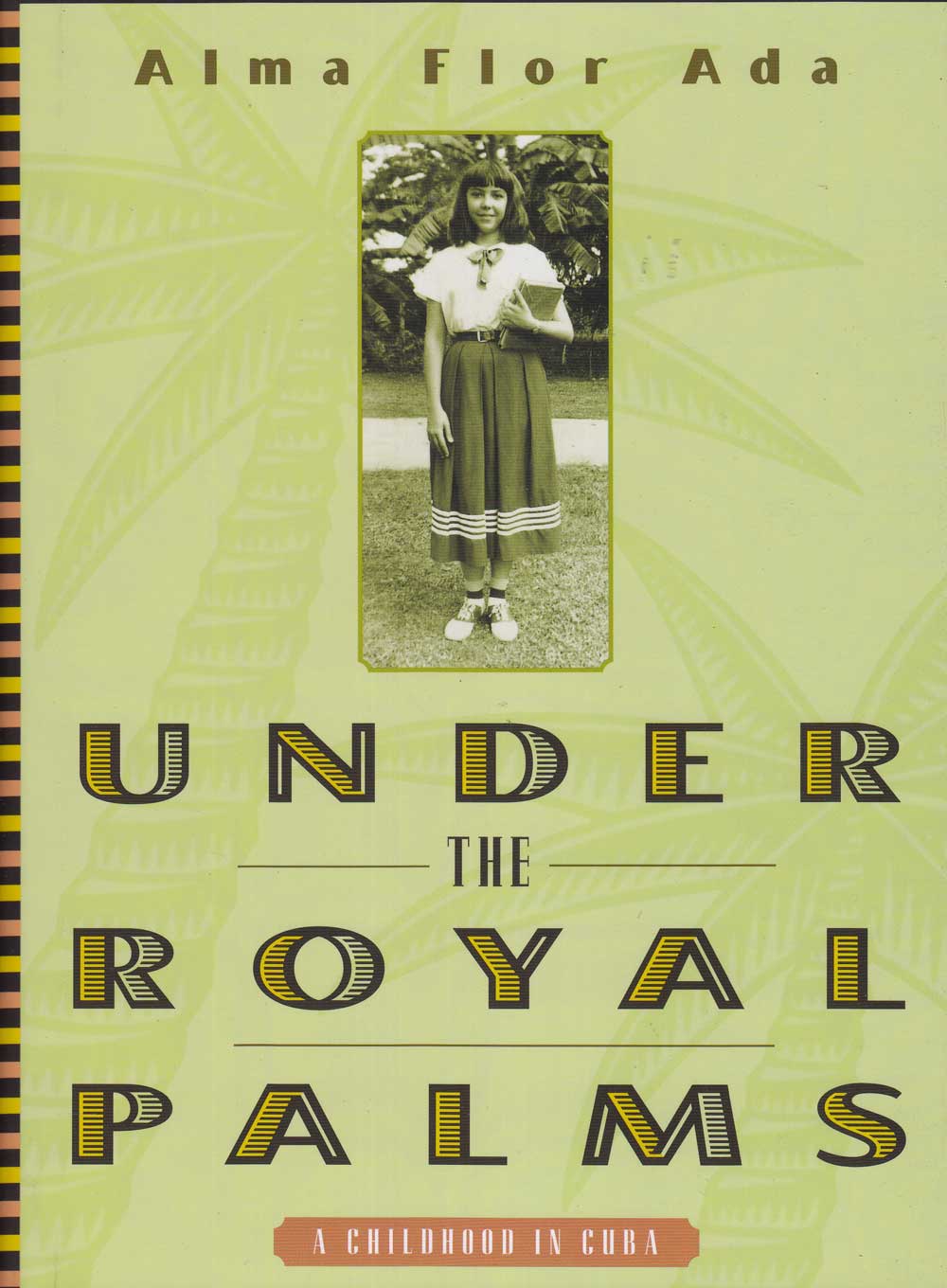 Powells : In this
companion volume to Alma Flor Ada's Where the Flame Trees Bloom, the
author offers young readers another inspiring collection of stories and
reminiscences drawn from her childhood on the island of Cuba. Through those
stories we see how the many events and relationships she enjoyed helped shape
who she is today. We learn of a deep friendship with a beloved dance
teacher that helped sustain young Alma Flor through a miserable year in
school. We meet relatives, like her mysterious Uncle Manolo, whose secret, she
later learns, is that he dedicated his life to healing lepers. We share the
tragedy of another uncle whose spirited personality leads to his love of
flying...and the crash that takes his life. Heartwarming, poignant, and
often humorous, this collection encourages children to discover the stories in
their our own lives — stories that can help inform their own values and
celebrate the joys and struggles we all share no matter where or when we grew
up. Synopsis : The
author recalls her life and impressions growing up in Cuba. In
this companion volume to Alma Flor Ada's Where the Flame Trees Bloom, the
author offers young readers another inspiring collection of stories and
reminiscences drawn from her childhood on the island of Cuba. Through those
stories we see how the many events and relationships she enjoyed helped shape
who she is today. We learn of a deep friendship with a beloved dance
teacher that helped sustain young Alma Flor through a miserable year in
school. We meet relatives, like her mysterious Uncle Manolo, whose secret, she
later learns, is that he dedicated his life to healing lepers. We share the
tragedy of another uncle whose spirited personality leads to his love of
flying...and the crash that takes his life. Heartwarming, poignant, and
often humorous, this collection encourages children to discover the stories in
their our own lives — stories that can help inform their own values and
celebrate the joys and struggles we all share no matter where or when we grew
up.
Powells : In this
companion volume to Alma Flor Ada's Where the Flame Trees Bloom, the
author offers young readers another inspiring collection of stories and
reminiscences drawn from her childhood on the island of Cuba. Through those
stories we see how the many events and relationships she enjoyed helped shape
who she is today. We learn of a deep friendship with a beloved dance
teacher that helped sustain young Alma Flor through a miserable year in
school. We meet relatives, like her mysterious Uncle Manolo, whose secret, she
later learns, is that he dedicated his life to healing lepers. We share the
tragedy of another uncle whose spirited personality leads to his love of
flying...and the crash that takes his life. Heartwarming, poignant, and
often humorous, this collection encourages children to discover the stories in
their our own lives — stories that can help inform their own values and
celebrate the joys and struggles we all share no matter where or when we grew
up. Synopsis : The
author recalls her life and impressions growing up in Cuba. In
this companion volume to Alma Flor Ada's Where the Flame Trees Bloom, the
author offers young readers another inspiring collection of stories and
reminiscences drawn from her childhood on the island of Cuba. Through those
stories we see how the many events and relationships she enjoyed helped shape
who she is today. We learn of a deep friendship with a beloved dance
teacher that helped sustain young Alma Flor through a miserable year in
school. We meet relatives, like her mysterious Uncle Manolo, whose secret, she
later learns, is that he dedicated his life to healing lepers. We share the
tragedy of another uncle whose spirited personality leads to his love of
flying...and the crash that takes his life. Heartwarming, poignant, and
often humorous, this collection encourages children to discover the stories in
their our own lives — stories that can help inform their own values and
celebrate the joys and struggles we all share no matter where or when we grew
up.
Publishers Weekly :
In this handsomely designed companion volume to Where the Flame Trees Bloom, Ada
once again draws upon her experiences growing up in post-war Cuba. In a short
introduction, the author describes her hometown, Camaguey, as a "city of
contrasts" diverse religions and education and economic levels ("some
had so much and others had very little"). The 10 stories that follow do not
focus on these oppositions so much as the unique experiences of young Alma and
her extended family. Several memories poignantly expose the disparity between
those who have and those who have not, such as "Explorers," in which
young Alma and her cousin get lost in a marabu field and are aided and fed by a
poverty-stricken family. Others illustrate life lessons (for example, the
impossible but gleeful task of counting bats in flight for their nightly feeding
taught Alma to appreciate the process of an endeavor, rather than its
completion). But the best of these stories simply recreate a poignant or
humorous moment from the author's girlhood: Alma sipping from a porron (a small
clay pot) at school, lovingly filled with water by her mother; Alma's pride in
her uncle's daring turning to grief when he dies in an airplane crash. Many of
the stories stand well alone, but some take a meandering expository path to
recount a history or explain a term. These more formal (though often graceful)
tangents distance readers from the slices of life. Still, at the core of the
collection, there is a heartfelt portrayal of a quickly disappearing culture and
a vastly beautiful land. Ages 8-12.
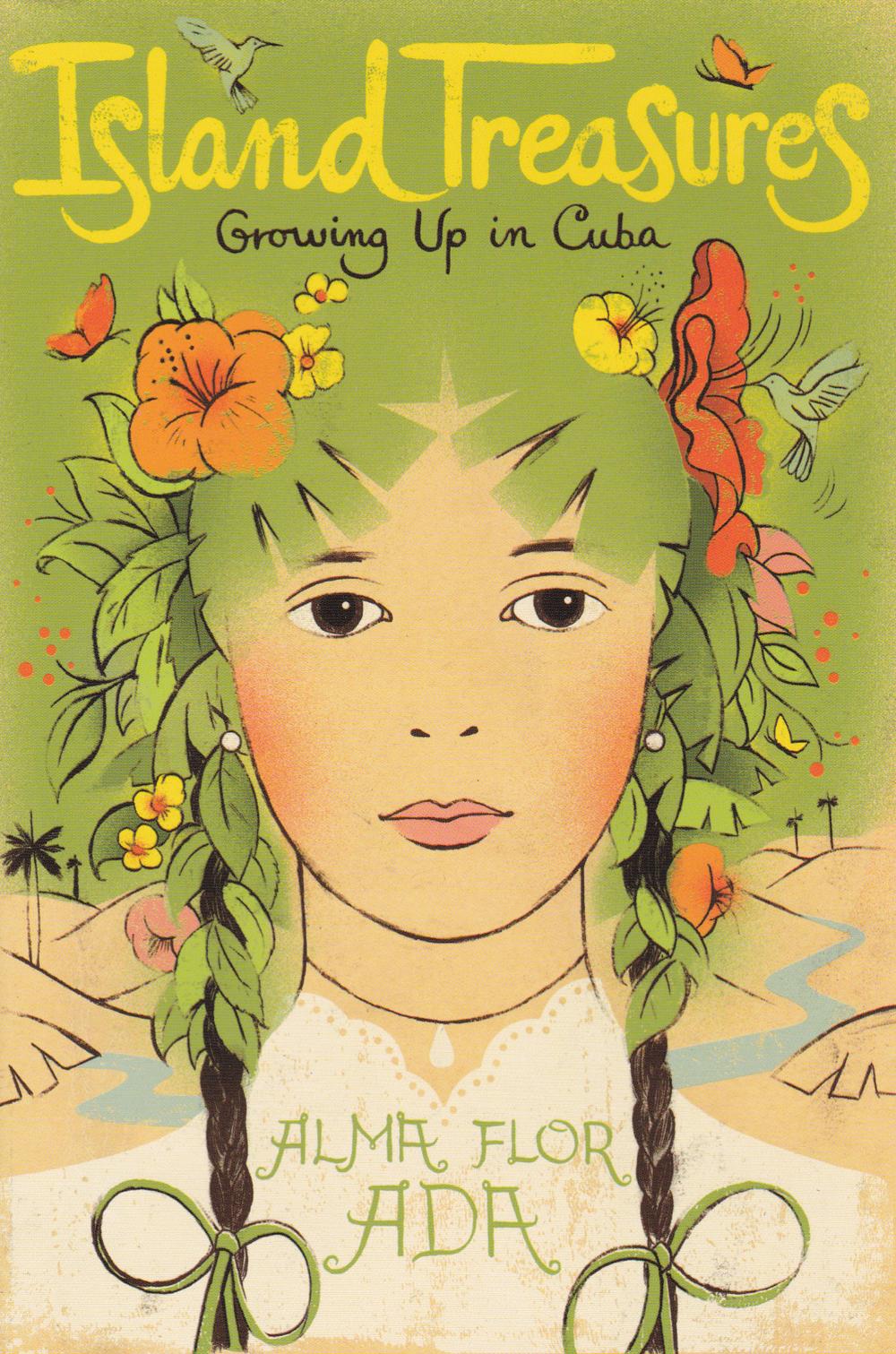 School Library Journal : Grade 4-7-This simple and graceful reminiscence of a
childhood in Cuba in the 1940s is a companion to Where the Flame Trees Bloom (Atheneum,
1994). Although not wealthy, the author's family lived comfortably with aunts,
uncles, and cousins in a large, shared family home in the small town of Camaguey.
Here any event beyond the ordinary became the focus of everyone's attention and
the fuel for many days of conversation. Each chapter includes an early memory or
experience of Ada's: nursing the baby bats that fell onto her porch, the
production of simple and inexpensive plaster figures for nativity scenes, etc.
The author writes about the contrast of wealth and poverty in her country at
that time and of the people who made an impression on her, including a ballet
teacher who befriended her during a lonely year in a new school, and an uncle
and aunt who worked with lepers. Her observations of people lead to a series of
revelations that shaped her life. Black-and-white photographs of the author and
her family appear throughout.
School Library Journal : Grade 4-7-This simple and graceful reminiscence of a
childhood in Cuba in the 1940s is a companion to Where the Flame Trees Bloom (Atheneum,
1994). Although not wealthy, the author's family lived comfortably with aunts,
uncles, and cousins in a large, shared family home in the small town of Camaguey.
Here any event beyond the ordinary became the focus of everyone's attention and
the fuel for many days of conversation. Each chapter includes an early memory or
experience of Ada's: nursing the baby bats that fell onto her porch, the
production of simple and inexpensive plaster figures for nativity scenes, etc.
The author writes about the contrast of wealth and poverty in her country at
that time and of the people who made an impression on her, including a ballet
teacher who befriended her during a lonely year in a new school, and an uncle
and aunt who worked with lepers. Her observations of people lead to a series of
revelations that shaped her life. Black-and-white photographs of the author and
her family appear throughout.
The New York Times
Book Review : The success of ''Under the Royal Palms: A Childhood in Cuba,'' the
companion volume to Alma Flor Ada's ''Where the Flame Trees Bloom,'' derives in
no small part from its appeal to adults as well as children. The author, a
professor of multicultural education at the University of San Francisco who has
written a number of children's books, understands that to get to a child's
bedroom shelves, often a book must first enchant choosy adults to buy it. And
enchant this one does. The slim, handsome book is divided into 10
chapters, each a self-contained story about Ada's childhood half a century ago
in Camaguey, a city in the province of the same name in the center of Cuba,
known as the cradle of great poets and courageous freedom fighters. The stories
and the endearing black-and-white photographs of her family are woven into a
greater theme: everything Ada learned about life, she explains, she learned in
her small town, surrounded by family and nature. Although this feels preachy at
times, most parents would surely not mind the lessons. For instance, after
telling how she spent childhood evenings trying to count bats with her loving
grandmother, she draws an eminently sensible conclusion that could easily be
applied to many an apparently vain effort: ''On the many occasions when I have
later felt that I am once more trying to count bats, engaged in an impossible
task, I have allowed myself to laugh, happy to remember that some of the best
things in life are like counting bats: it was never the final count that
mattered, but rather the joy of seeing them fly.''
Kirkus Reviews : Of books comprising nuggets of memory there seems to be no end,
and in a companion volume to her Where the Flame Trees Bloom (1994, not
reviewed), Ada recounts small stories of growing up in the town of in Camagey,
Cuba. She captures with some feeling the powerful effect of scent on memory:
night jasmine, coffee, ylang-ylang, and her grandmother's perfume of lavender
and sage. She immortalizes sibling hurts and uncles' gifts, and writes of the
childhood mystery of adult conversations partially overheard and partially
understood. She is rich in family, attempting with her grandmother the
impossible task of counting bats as they fly, and smashing her favorite doll
when her dashing uncle dies in a plane crash. She is rich in memories of other
adults, too: Madame Marie, a French-Jewish refugee; Gilda, a dance teacher,
whose affection carried Ada through an impossible year at school. Some
repetition does not detract, and children might be moved by Ada's exhortation to
consider their own family stories.
CLASP : Alma Flor Ada offers stories about Cuba that would not otherwise be available to those of us living in the United States. This collection provides the reader with a close look at an active and loving extended family. It chronicles events that would probably stand out for lots of children growing up throughout history and across geographical boundaries: living in different houses, in the city and in the country... and the tragic death of a beloved young uncle. This volume provides information on a prolific author that is accessible and helpful to readers studying Latino writers."
Booktalks : Who knows where Cuba is? Alma Flor Ada takes us to Cuba and describes her memories as a little girl there. You will feel like you are right there feeling everything she is. As you read you will be able to see the photos of her family and friends which make it come to life even more. We all have fun times in our lives and we also have tragedies happen. Alma Flor Ada describes her Uncle's plane crash and I thought I was right there. To see what Cuba is like and Alma's memories of her childhood you must read "Under the Royal Palms" by Alma Flor Ada.
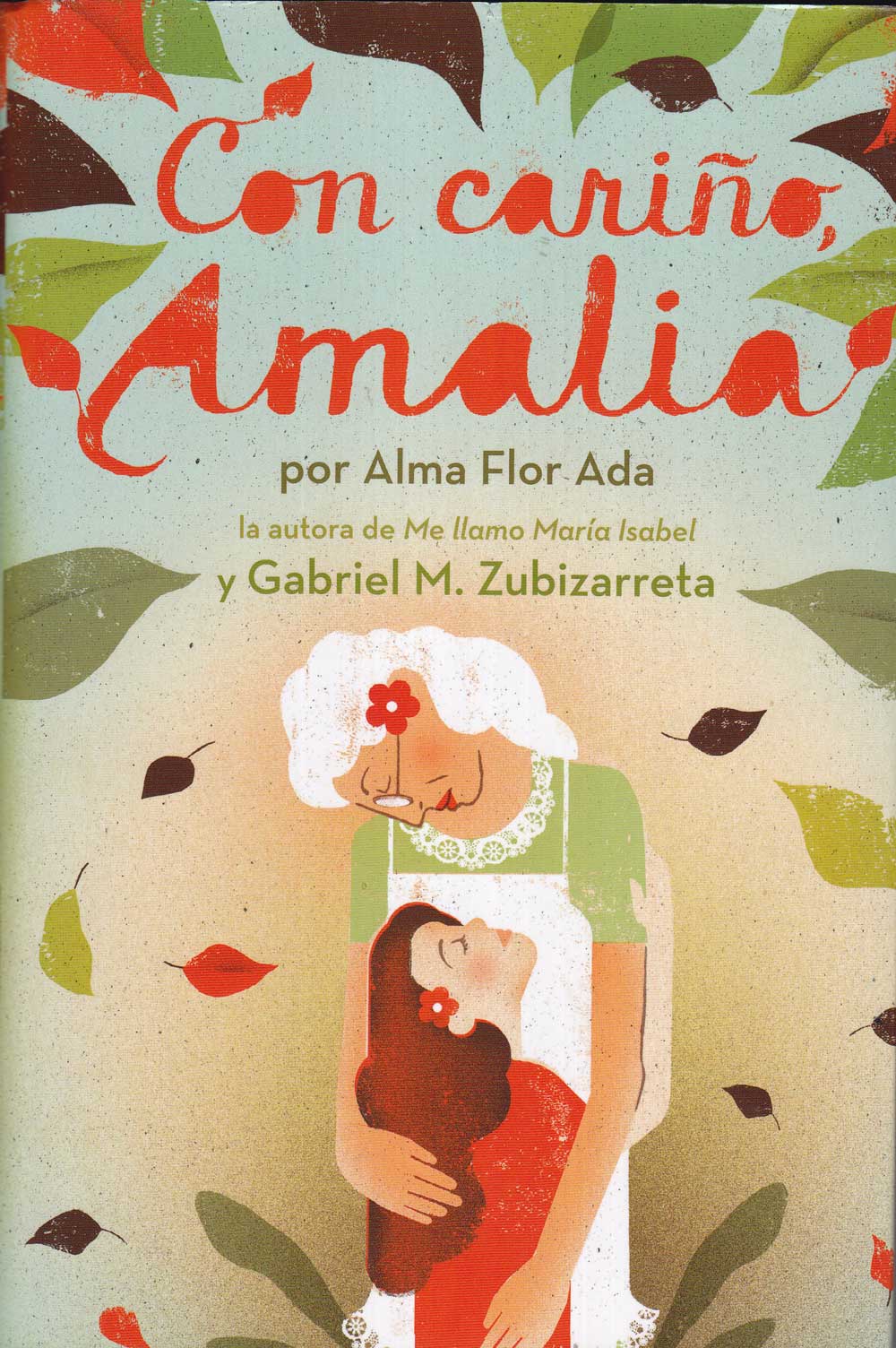 Con
Carina Amalia
Con
Carina Amalia
With Love Amalia
Amalia deals with loss while learning about love and her cultural heritage in this tender tale from acclaimed authors Alma Flor Ada and Gabriel M. Zubizarreta. Amalia’s best friend Martha is moving away, and Amalia is feeling sad and angry. And yet, even when life seems unfair, the loving, wise words of Amalia’s abuelita have a way of making everything a little bit brighter. Amalia finds great comfort in times shared with her grandmother: cooking, listening to stories and music, learning, and looking through her treasured box of family cards. But when another loss racks Amalia’s life, nothing makes sense anymore. In her sorrow, will Amalia realize just how special she is, even when the ones she loves are no longer near? From leading voices in Hispanic literature, this thoughtful and touching depiction of one girl’s transition through loss and love is available in both English and Spanish.
School Library Journal Gr 3-5-Amalia is upset when her best friend announces that she is moving from Chicago to California. When Martha leaves, Amalia turns to her grandmother for comfort. It is in her kitchen and at her table that the child learns not only about her family and her Mexican heritage, but also about herself. As Abuelita shares her Christmas-card ritual with her granddaughter, Amalia is given glimpses of her aunts and uncles and her mother, and notices the care that Abuelita takes in her communication and responses with everyone. It's quite the the opposite of how Amalia treated Martha at the time of her move. When her grandmother dies suddenly, the child feels lost. Her extended family, whom she has heard so much about, is suddenly around, but instead of making her feel better, she feels worse. Through flashbacks, readers see just how close Amalia was to Abuelita and how much she relied on her for comfort and advice. Over time, with the help of the cherished Christmas-card box, she begins to heal, and by recalling Abuelita's words and deeds, she begins to reach out to her family members, and to Martha as well. This story utilizes a special intergenerational relationship to introduce Mexican culture and traditions within the themes of changing family and friendships. Spanish words and phrases are woven into the text. While it does not break new ground, this quiet story may provide a different perspective on the loss of a loved one.
Kirkus Reviews : Ada and Zubizarreta (Dancing Home, 2011) reunite to focus on a young Latina girl coping with loss…. The authors tackle issues of love, loss and familial ties with a sympathetic, light hand and blend Spanish words and Latino music and recipes into Amalia’s tale. A charming story, especially for children facing the loss of grandparents.”
“Horn Book
Magazine : With sensitively drawn characters and a low-key story moving
between present and past, the authors construct a portrait of a
multigenerational immigrant family. The Latino culture of the family is
reflected in the cooking the two do together, the memories Abuelita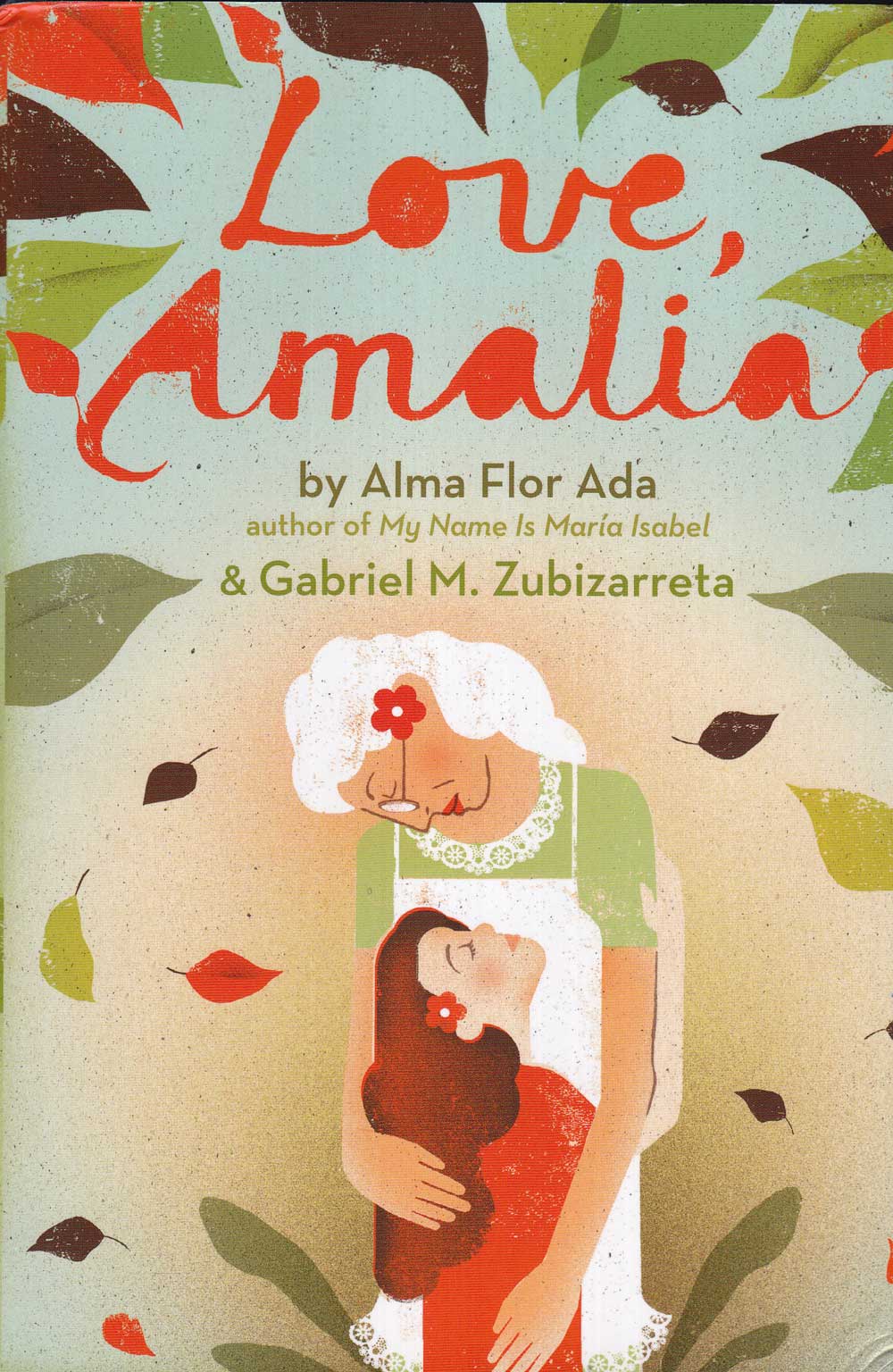 passes on, and all the
letters she has kept from distant loved ones.”
passes on, and all the
letters she has kept from distant loved ones.”
Publishers Weekly : Ada and Zubizaretta’s (Dancing Home)…collaboration focuses on the deep bond between Mexican-American sixth-grader Amalia and her grandmother…. The authors successfully depict family love and closeness across generations and distances…. In the final chapters…the book…takes on an authentic emotional poignancy, bringing a closing richness to this story of a girl’s first experience of loss.”
“Booklist : Latina sixth-grader Amalia is so upset by her best friend Martha’s move from their Chicago neighborhood to California that she can’t even say good-bye. When her beloved abuelita passes away suddenly a few days later, she doesn’t even have the chance to say good-bye….Sprinkled with Spanish words and phrases, this quiet story charmingly emphasizes the importance of both friendship and intergenerational relationships. It concludes with simple recipes for making some of Abuelita’s favorite desserts.”
Con Carino Amalia
Reading Group Guide :
http://books.
Love Amalia
Reading Group Guide : http://books.
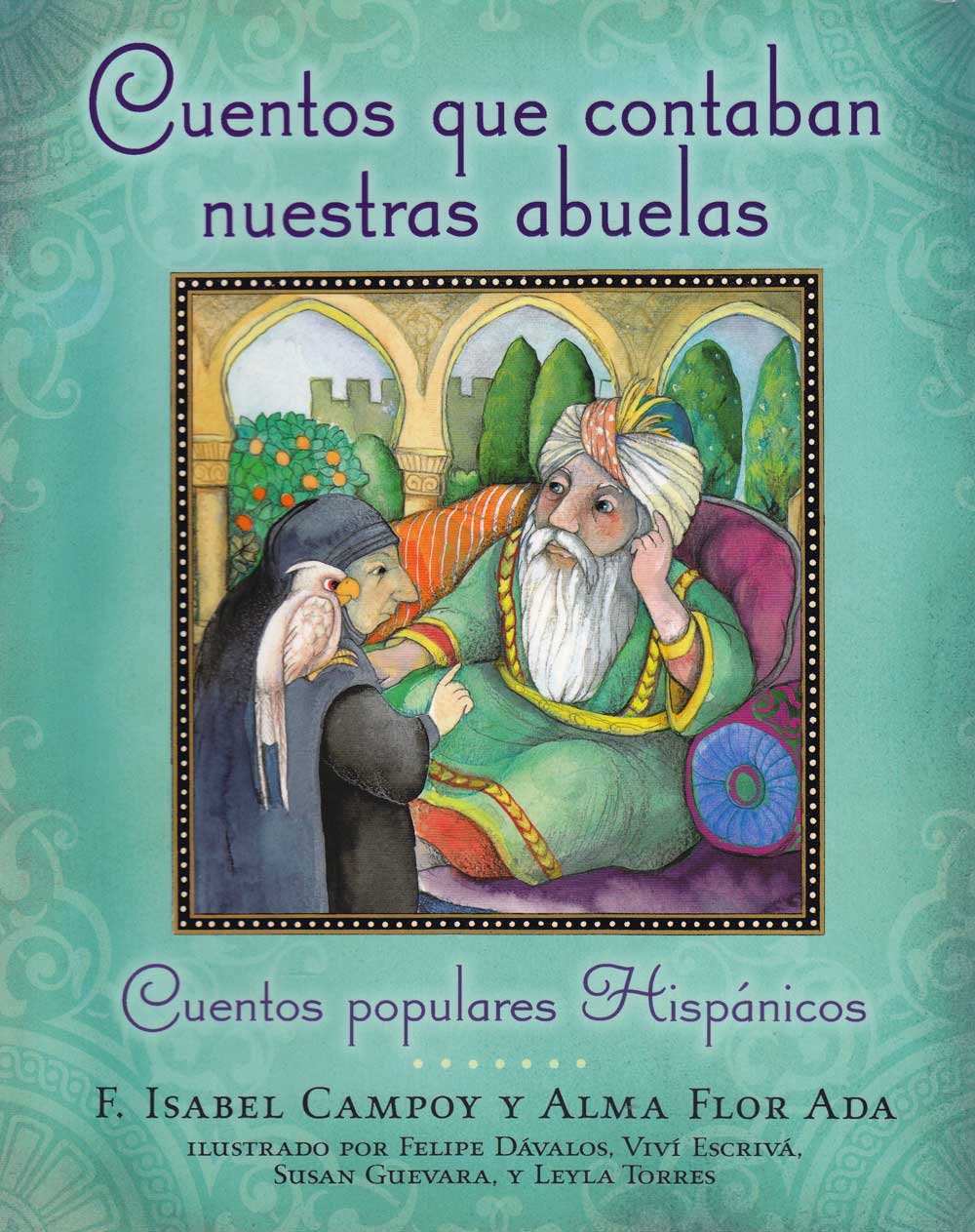 Cuentos que contaban nuestras abuelas
Cuentos que contaban nuestras abuelas
Tales Our Abuelitas Told
American Federation of Teachers' Colorín Colorado's Website, Featured Book of the Month
Kirkus Review, List of 100 Best Children´s Books
Literary Guild Award
New York Public Library, List of Best Children´s Books
Nick Jr. Magazine, List of Best Children´s Books
Parent´s Choice Recommended Children´s Books
Authors' Note : Writing Tales Our Abuelitas Told was for me a way of honoring my extraordinary grand mother, Dolores Salvador, as well as and an expression of love and hope for my nine grandchildren, as I have expressed in my dedication. I am sure it means some thing very similar for Isabel, whose dedication is to her great-nephew Pablito. We are very grateful that these beloved tales are being so well received assuring that their continue to live for all children.
Traditional tales open our hearts to old voices and new worlds, to wondrous adventures and ever lasting feelings. Words like Había una vez or Érase que se era, hold for the listener or reader the magic promise of enchantment.
The stories retold Tales Our Abuelitas Told or, in the Spanish version Cuentos que contaban nuestras abuelas, reflect the diversity of our culture: some developed in Latin America from Indigenous roots, others had their origin in Africa or in various regions of Spain and go back to the Hebrew, Arabic or Basque traditions.
Their settings may be Mexico or the Southwest, Puerto Rico, Cuba or the Amazon among many others. They all keep children spellbound. Stories like these enriched our childhood and left our ima ination for ever open to new discoveries, to the daring possibility of dreaming better worlds. Words like ¨happily ever after¨ got trans formed into lives in search of understanding and compassion, lives devoted to pro mote access and equality for all, social justice, and peace.
Listen to Vienna Rose read Tales Our Abuelitas Told to you. A marvelous example of the magical encounter between a child and books that we wish for all children. And here's the book's
introduction read to you by Vienna Rose. And here's an
earlier reading by Vienna Rose.
From Catalina the Fox : "Stop, you rascal!" shouted Catalina, the fox, as she saw MartÍn, the wolf, rushing out of her orchard. Once again he has been stealing her reddest apples, her sweetest pears, her freshest eggs, and her fattest hen -- all the while laughing as he escaped. "Someday that wolf is going to get it!" Catalina muttered to herself. Catalina was so angry that she decided to go for a walk to calm herself. As she walked along the road, she saw a man approachng on a horse-drawn cart. She remembered much too well having been shot at by a man on a similar cart the previous fall. Since there was nowhere to hide, she thought the best way to avoid the trouble was to pretend to be dead. So she laid down by the side of the road. "A dead fox!" cried out the man in the cart. "I can use that fur." The man climbed down from his cart, took the fox by the tail, and swung her up on top of the fish barrels that he was taking to market. This was not exactly what the fox had planned, but she remembered her grandmother's advice: "Look for the good that is hidden inside every bad situation." The only good thing she could see were the sardines in the fish barrels beneath her.
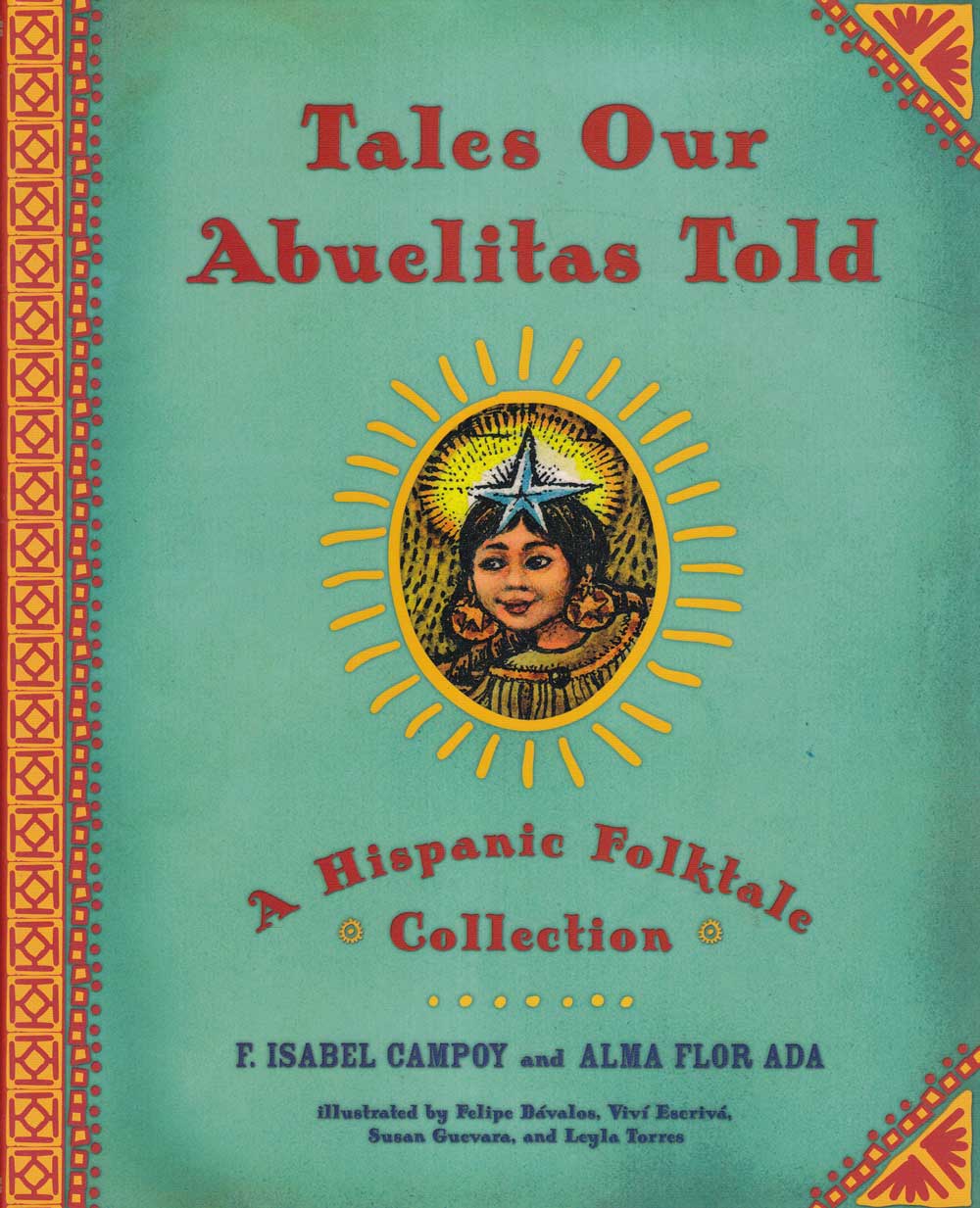 School Library Journal : Grade 3 Up The introduction to this delightful collection explains clearly how stories develop and change over time; in fact, the two storytellers heard most of these amusing tales when they were children and have retold them many times since in their own unique styles. Each retelling is accompanied by a brief description of its origin. Included are tales about dancing goats, a turtle that outwits a deer, and a beetle that declares war on a cow; all of the selections are peppered with energetic dialogue and witty detail. Children will relish their humor, especially if read aloud, and teens will also enjoy this lively presentation. Traditional story beginnings and endings are provided in Spanish and translated into English, including one foreboding opening: In a land where you will go but from where you will never return. Four Latino artists provide an interesting variety of illustration. Featured images include a large goat head in a vegetable garden, a large farmer on a very small burro, and a wolf and fox all decked out in finery dancing together. The last page provides information about the authors and illustrators.
School Library Journal : Grade 3 Up The introduction to this delightful collection explains clearly how stories develop and change over time; in fact, the two storytellers heard most of these amusing tales when they were children and have retold them many times since in their own unique styles. Each retelling is accompanied by a brief description of its origin. Included are tales about dancing goats, a turtle that outwits a deer, and a beetle that declares war on a cow; all of the selections are peppered with energetic dialogue and witty detail. Children will relish their humor, especially if read aloud, and teens will also enjoy this lively presentation. Traditional story beginnings and endings are provided in Spanish and translated into English, including one foreboding opening: In a land where you will go but from where you will never return. Four Latino artists provide an interesting variety of illustration. Featured images include a large goat head in a vegetable garden, a large farmer on a very small burro, and a wolf and fox all decked out in finery dancing together. The last page provides information about the authors and illustrators.
Booklist : The long chatty notes are as interesting as the 12 folktales in this anthology of stories retold by Ada and Campoy and illustrated by well-known Latino artists. The authors celebrate Hispanic culture and its many roots--indigenous, African, Spanish, Arab, Hebrew--assembling tales from as far afield as Spain and Idaho, and showing how the tales have transformed and influenced one another, and even how Ada and Campoy have changed them. The folklore universals are here: the kid who defeats his mean older brothers; the huge monster routed by an ant; and more. In "Blancaflor," the evil king's daughter and the young prince fulfill three tasks together and prove the power of love. The spacious book design will work well for both independent reading and reading aloud, and each story is illustrated with one or more full-page pictures in styles that match the stories--from busy and filled to bursting to light and airy.
Children's Literature : A six-page introduction welcomes readers and offers historical background into the ways that folktales originated and intermingled in all cultures. The twelve Hispanic tales actually have roots in many ancient traditions. The conversational tone continues into the retelling of the selected tales ranging in length from three to seventeen pages (including at least one full-page illustration for each). A few of the tales will seem somewhat familiar. "Dear Deer! Said the Turtle" is reminiscent of "The Tortoise and the Hare." "The Castle of Chuchurumbe" has a rhythm similar to "The House That Jack Built." Catalina the Fox could be related to Brer Rabbit. Other tales bring fresh, new perspectives. Pedro saves his family's corn and, eventually, finds great happiness because he befriends a little horse of seven colors and follows its advice. A caliph and his son discover the source of true happiness in unexpected places. Research and explanatory notes follow each tale. Colorful illustrations capture the mood of the narrative, often contributing to understanding of the text and adding humor. The artists are given individual recognition in the table of contents. A listing of traditional folk tale beginnings is provided in both Spanish and English in the front of the book. A similar listing of endings appears in the back. The large-style format lends itself well to both individual reading and group sharing.
Simon Brooks : I have gone into the studio to begin recording what is most likely to be called “More Second-hand Tales.” I know, amazingly original, isn’t it? For those who saw me over this summer, you might remember me telling the story ‘The Goat from the Hills and Mountains.” This tale was new to me this year and I have fallen in love with it. It is based on an Hispanic tale I found in a marvelous book called TALES OUR ABUELITAS TOLD by F. Isabel Campoy and Alma Flor Ada, published by Atheneum. I could not find an original source for the story, or any other version of it, so I approached the authors for permission to continue telling the tale and also for permission to record it, on this soon-to-be-made second CD. After a few emails with both writers I have permission to continue to tell the story AND record my version of Alma Flor Ada's version of this story which appears in the book. The book is wonderful, and there are many other great stories in there. If you are looking for a holiday gift to give someone this coming winter season, be it Christmas, Chanukah, Quanza, or any other holiday, or birthday even, then look this book over. It is not a ‘dry’ folklore book, but a book filled with the life and vitality which makes Hispanic stories so wonderful. It is also illustrated in a style that captures the tales in a unique way that kids love. I know this as we have a copy of it at my library. Many thanks to Isabel and Alma for graciously allowing me to take this tale and put it on my second CD.
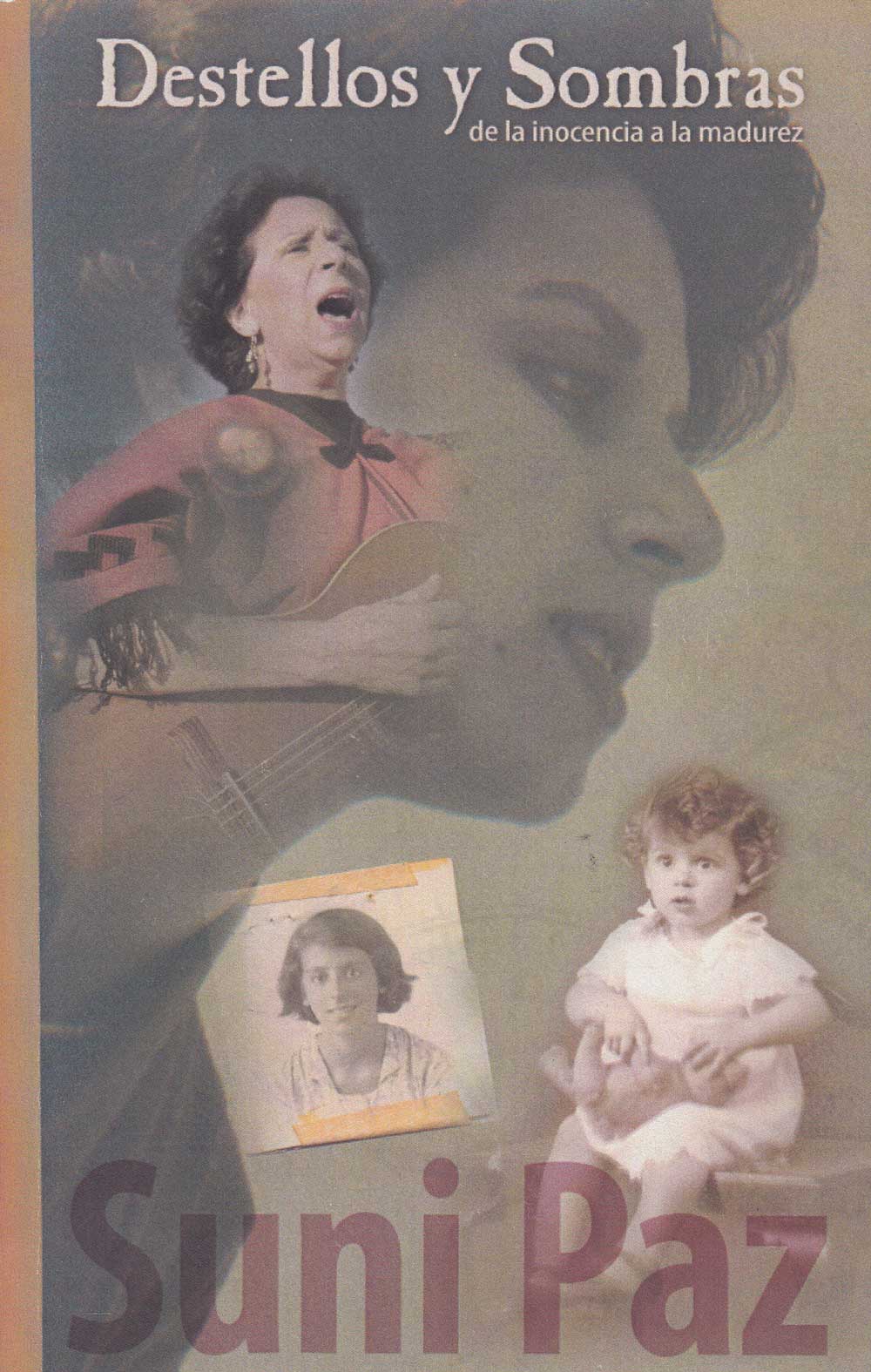 Destellos
y Sombras
Destellos
y Sombras
Sparkles and Shadows
Author's Note : This book is a memoir written with anecdotes. It is the saga of an Italian-Argentine family, the Calandrelli family. They gave birth to talented, original people whose works became published, printed, played and recognized in Argentina, in Europe and in the United States. Their lives were lived in Buenos Aires, a bustling city even in the 1900, but with mores, beliefs and happenings that move from the innocent, to the humorous, to the terrifying. Throughout the book runs a thread of love and understanding of the values and prejudices of the times. Of this book, it was said: “Here, early encounters with prejudice are recounted with unflinching honesty and tales of immigration told with such timeless tenderness and thoughtful insight that they remain fully relevant to today’s world.” Among the characters in the book we find an aunt that makes magic, is a writer, a graphologist, an amateur astronomist and becomes a celebrated poet writing in French and in Spanish; an uncle who is a pianist and an inventor; a grandfather that is a well-known doctor, a musician, and a poet; a grandma, an artist, not an architect, that makes blue prints for a house she is set to build in the middle of nowhere; a mother that in her deathbed sees Death entering through a balcony, and a four-year-old musical genius that ends up in the United States with 25 Grammy nominations, two Grammys won, and two Oscars. Finally, the author of Sparkles and Shadows is the recipient of several awards, a performing artist, a singer and a songwriter with more than four hundred recorded songs. To make this saga more real, today, in the hills of Rome, in the Trastevere, one can see busts of members of the Calandrelli family with a nearby street named after them: Via Calandrelli. I, personally, must add that I wanted my children to know what kind of family they came from, what heritage they had behind, the makings of their DNA. Today, too many children have no roots, no relatives around that can remind them of who they are. With no known heritage behind, children look for a place to belong to, usually gangs or drugs. If we want strong families, strong children, that is, strong “trees,” we need to give them strong “roots.” A way to do that is by telling them the story of their families and when possible, keep alive their language and their culture.
Listen to Vienna Rose read Sparkles and Shadows to you. A marvelous example of the magical encounter between a child and books that we wish for all children.
Early encounters with prejudice and tales of immigration are told with unflinching honesty and with such untimeless tenderness and thoughtful insight that they remain fully relevant to our current curcumstances. Throughout this memoir, exposure to European culture never overshadows the powerful influence of folklore and the Argentine avant garde on the artist's childhood. - Lisa Stewart Garrison
Enchanted and profound, this book invites the reader to take part in the intimate experiences of the author. What makes her stories unfortgettable is the authenticity of the voice and the cadence of her word. A book to be treasured. - Dr. Alma Flor Ada
This author submerges us in a pleasant voyage of discovery of the intimate, fragile, and subtle of the human experience. Then, she invites our hearts to a big laugh by introducing us to situations unthinkable in 20th Century Argentina. Suni Paz offers these flowers of her passion to our enjoyment and, surprisingly, to our reflection. A magnificent book! - F. Isabel Campoy
How good to find once in a while such a special book. After reading many autobiographical stories Suni's appeared, filled with a million histories, told with clear and involving language. Her work reunites the indispensable prerequisites to a good reading and transports us to our own history. - Clarita Kohen Klieman
“Here, early
encounters with prejudice are recounted with unflinching honesty and tales of
immigration told with such timeless tenderness and thoughtful insight that they
remain fully relevant to today’s world.” Lisa Stewart Garrison, New
Jersey
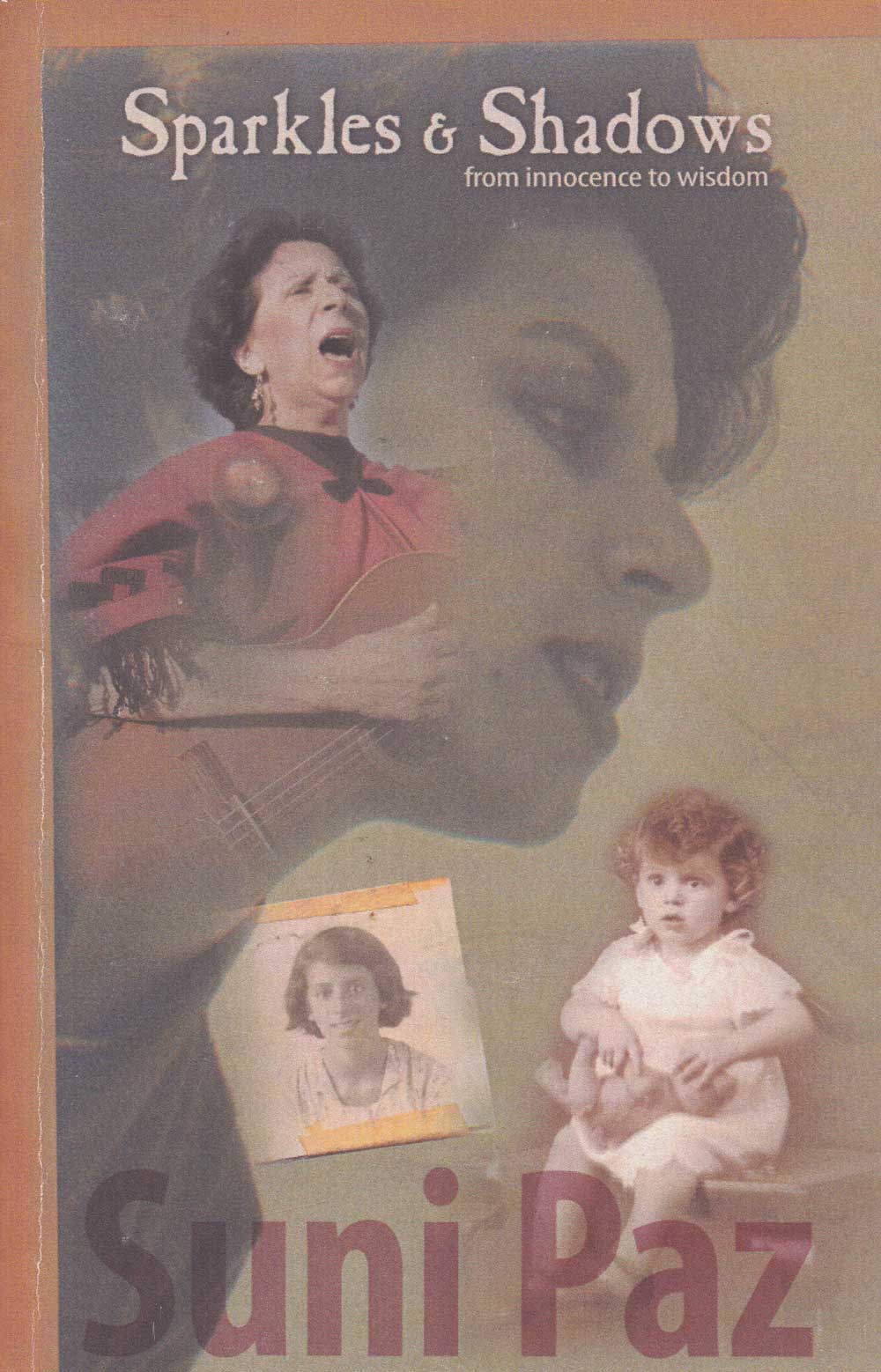 Dear Suni, I just
wrote you a long letter. Mostly, I was saying how much I enjoyed the book and
talking about certain passages that were special for me, like Tiasu's (your
aunt’s) childrearing methods (your first job, the bottle of anise); Martina
and how beautifully you wrote about your friendship and your sadness; the
unshakable determination of your brother Jorge. I really felt your respect
and love for people in your life. It is a series of vignettes, and they each
stand on their own. I know you have the right to choose what to include in your
book but I had questions though. I wanted more information about your
relationship with your mother in order to appreciate the meaning of the chapter
when you were taking care of her. It is poignant that the times when you could
have her as a child were when you were sick and then it was she who was sick and
you who were there for her. The fact that it was mostly Tiasu who raised
you makes me feel that you were very fortunate to have your aunt and that it was
sad that you lost touch with her. I also loved your camaraderie with her and
that she shared her writing with you. I would like to buy a Spanish copy
from you. I'm so glad I will get to see you (hopefully) next month. Here, we're
all fine. Have a very happy new year.” Mara Goodman, New York
Dear Suni, I just
wrote you a long letter. Mostly, I was saying how much I enjoyed the book and
talking about certain passages that were special for me, like Tiasu's (your
aunt’s) childrearing methods (your first job, the bottle of anise); Martina
and how beautifully you wrote about your friendship and your sadness; the
unshakable determination of your brother Jorge. I really felt your respect
and love for people in your life. It is a series of vignettes, and they each
stand on their own. I know you have the right to choose what to include in your
book but I had questions though. I wanted more information about your
relationship with your mother in order to appreciate the meaning of the chapter
when you were taking care of her. It is poignant that the times when you could
have her as a child were when you were sick and then it was she who was sick and
you who were there for her. The fact that it was mostly Tiasu who raised
you makes me feel that you were very fortunate to have your aunt and that it was
sad that you lost touch with her. I also loved your camaraderie with her and
that she shared her writing with you. I would like to buy a Spanish copy
from you. I'm so glad I will get to see you (hopefully) next month. Here, we're
all fine. Have a very happy new year.” Mara Goodman, New York
Dear Suni, I’ve
just read your book and enjoyed it through and through. I will order it in
Spanish when I return to San Diego and read it again. The clarity and
intensity of your descriptions drew me in without a moments hesitation. I
loved the moments you chose to share and the compassion with which you offered
them… Let me know if you are in the San Diego area in the spring, I will be
there visiting… “ Hugs, Sarah Livia, London
“Dearest Suni, I have been thinking about you so much—your beautiful work and your beautiful spirit! I can’t wait to receive the book. Will it include a CD of your music? In Spanish I hope.” Sheri Ritchlin, California
“Encantador y
profundo, este libro invita al lector a tomar parte en las intimas experiencias
de la autora. Ya sea dolor o lucha, juego o ingenio lo que sus páginas
comparten, lo que las hacen inolvidables es la autenticidad de la voz y la
cadencia de sus palabras. Un libro para ser atesorado”. Alma Flor Ada,
California
“Esta autora nos
sumerge en un placentero viaje de descubrimiento de lo íntimo, lo frágil y lo
sutil de la experiencia humana. Y luego, invita a nuestro corazón a una inmensa
carcajada simplemente bosquejando situaciones impensables del siglo XX en
Argentina. Suni Paz nos ofrece estas flores de su pasión para nuestro disfrute
e insospechadamente para la reflexión. Un libro magnífico.” Francisca
Isabel Campoy, California
“¡Qué bueno
tropezarse de vez en cuando con una obra tan especial. Después de leer unos
cuantos cuentos autobiográficos aparecen los de Suni Paz, con una historia que
contiene mil historias. Contada con un lenguaje claro y envolvente, su obra reúne
los requisitos indispensables para pasar un buen momento y transportarnos a
nuestra propia historia”. Clarita Kohen Klieman, California
“Hola Suni: ¿Cómo
estás? Te escribo mientras voy en la mitad de tu libro. No lo he soltado cuando
pude agarrarlo. Ando embebida en esa niña tan lúcida y determinada. Desde
que te conocí me pareció que algo muy fuerte emergía de tu personalidad y
ahora lo confirmo. Después te cuento más cuando lo termine. Voy a seguir
ahora entre la fascinante Tiasu, las exquisitas citas de Atahualpa Yupanqui...
en fin… Espero tú estés bien y sigas escribiendo para seres como yo,
que ante la imposibilidad de recordar la niñez, revivimos como en
reminiscencias la pérdida de otro anillo, otra aventura llena de animalitos
amados... tías, o compañeras de escuela admirables. Así que después te
escribo otra vez cuando lo acabe…algunos libros dan pena que se terminen”.
Mariana Montes Shaw, California
“Hola, Suni: Te
escribo de nuevo, ya que he terminado de leer tu libro. Me gustó mucho.
Evidentemente tienes gran vena de escritora porque has transmitido en esos
cuentos algo muy vívido. He llorado y reído. La elección de los dos cuentos
finales y su contenido, me impresionaron mucho... Hasta he esbozado algún
escrito contagiada del relato autobiográfico, memorioso…” Mariana
Montes Shaw, California
“Hola, Suni: Con respecto a tu libro, te cuento que cuando lo leí, creo que te comenté que me gustó mucho. Me encantaron las escenas de tu hermano Matías cuidándote en la escalera de la casa de la calle Paraguay, y luego más adelante otra escena de Juan, tu hijo, cuidando de su hermanito Ramiro con una espada al lado de otra escalera, todo con imágenes muy ricas y descripciones que me gustaron mucho. Me acordé de la casa de Tula, a la que creo que yo fui algunas veces…” Leo Sicardi, psicólogo, sobrino de Suni
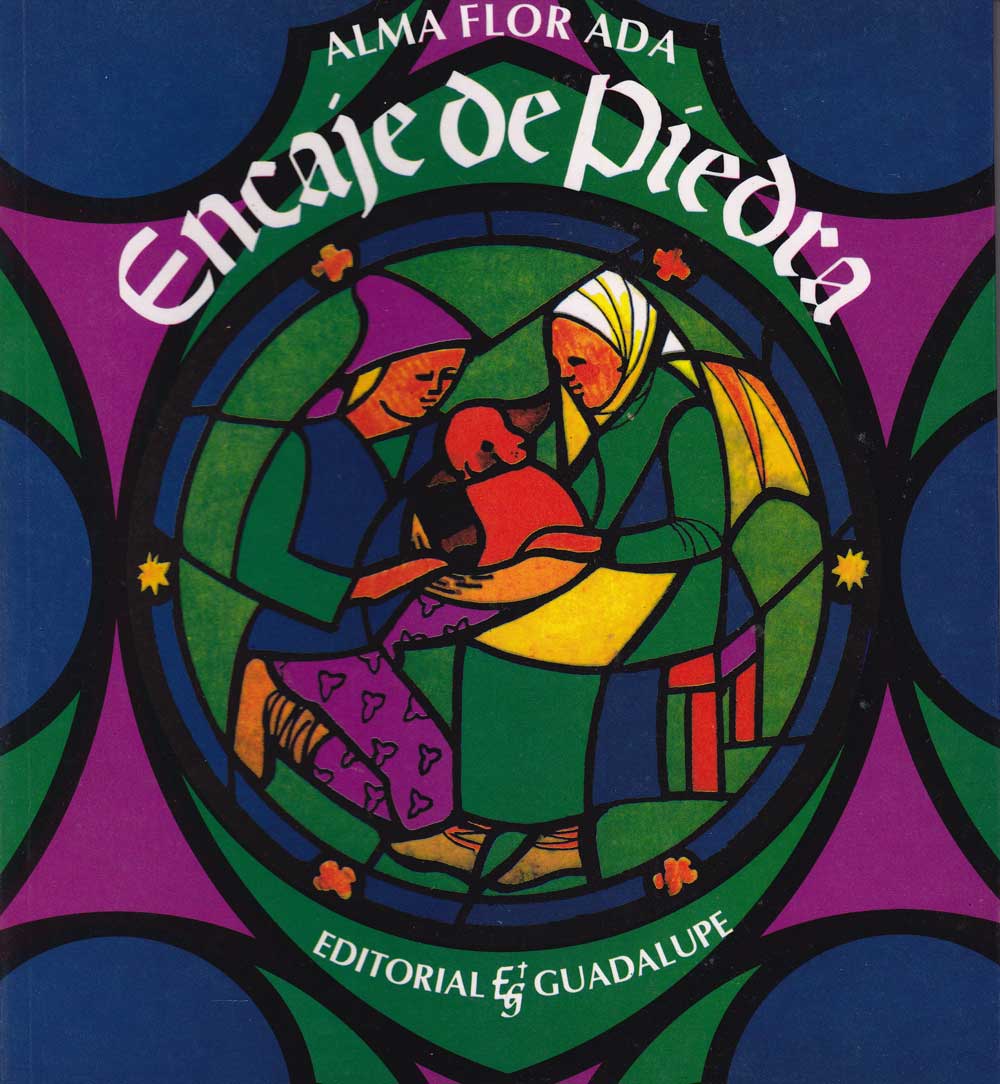 Encaje
de piedra
Encaje
de piedra
Marta Salotti Gold Medal, International Award for Children’s Literature, Buenos Aires, Argentina
This suspense-filled mystery is set in the Middle Ages, during the construction of the Cathedral of Burgos. Three young friends succeed in capturing some thieves in this award-winning story that includes themes of friendship and trust, discrimination and prejudice, and bilingualism/biculturalism. After reading this book, your students will view the advantage of speaking several languages in a new light. Black and white illustrations by Kitty Lorefice de Passalia. (4-12).
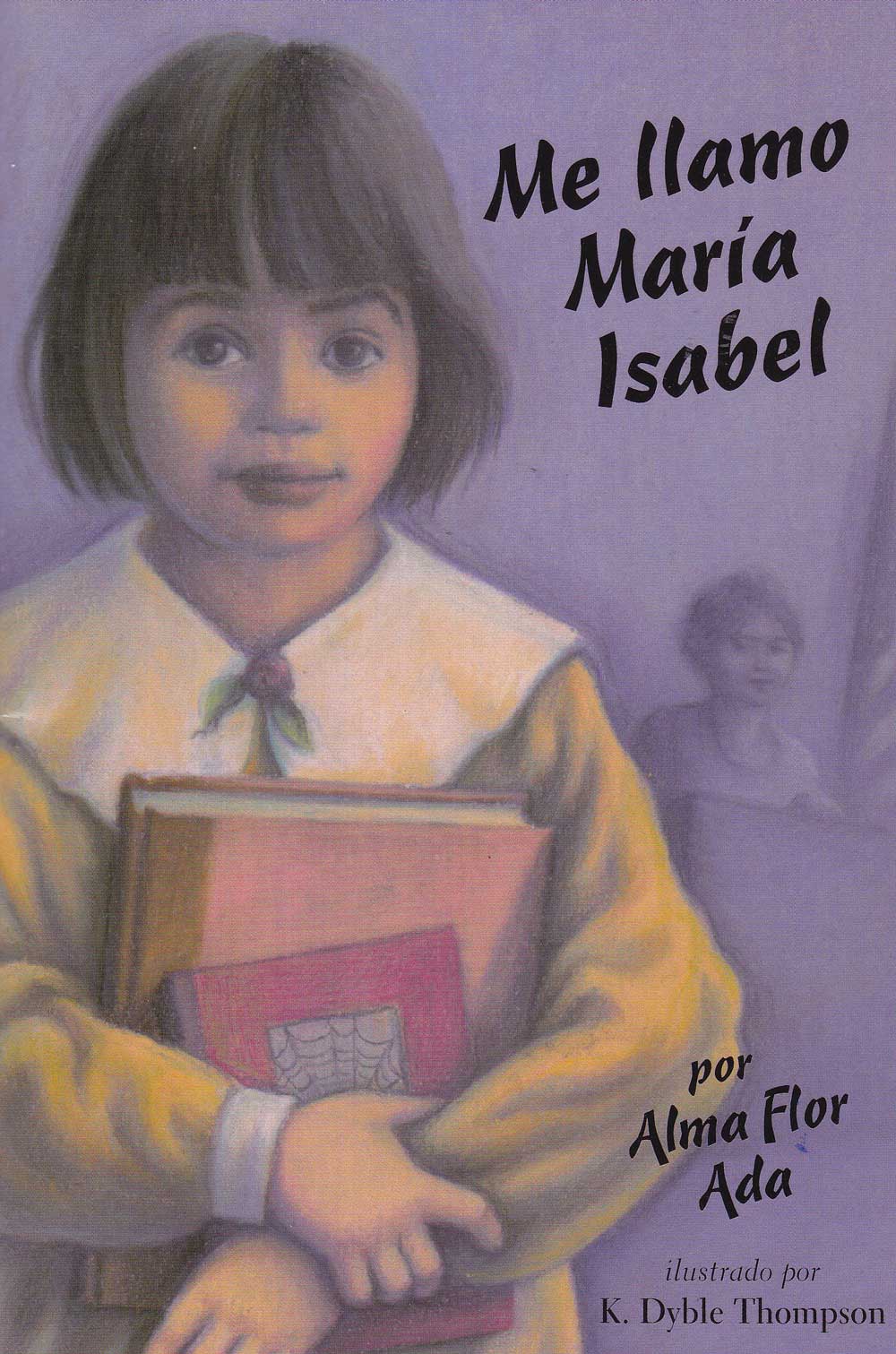 Me
llamo Maria Isabel
Me
llamo Maria Isabel
My Name is Maria Isabel
American Booksellers
Association, Pick of the List
Center for Latin American Studies, America´s Commended List
National Council of Social Studies and the Children’s Book Council, Notable
Book in the Area of Social Studies
My Name is Maria Isabel Online Comprehension Quiz and more
Publishers Weekly : Armed with her new blue bookbag, Maria Isabel bravely faces her first day at a new school. But when she meets her new teacher, she is told there are already two other Marias in the class. "Why don't we call you Mary instead?" her teacher suggests, unaware that Maria was named for both her grandmothers, a grandfather and her father. Maria's inability to respond to "Mary" leads to more problems. Simply told, this story combines the struggle of a Puerto Rican family's efforts to improve their life with a shared sense of pride in their heritage. The author's carefully drawn characterizations avoid stereotypes, thus increasing their appeal and believability. An essay involving a wish list gives Maria a chance to reclaim her name, and allows her teacher to make amends. Abetted by Thompson's straightforward black-and-white drawings, this contemporary tale serves as a good reminder that no two names are really alike. Ages 7-10.
Watch or Listen to Vienna Rose read My Name is Maria Isabel to you. A marvelous example of the magical encounter between a child and books that we wish for all children. And here's an earlier reading by Vienna Rose, and an even earlier reading.
School Library
Journal : Grade 3-4 This gentle story tells of Maria Isabel Salazar Lopez,
who finds herself dubbed "Mary Lopez" when her family moves and she is
placed in a class with two other Marias. Maria Isabel finds it hard to respond
to a name that does not seem like hers. Her teacher doesn't understand why it is
so difficult for her to answer to "Mary" until the child is inspired
to address her paper on "My Greatest Wish" to the topic of her name.
The result is not only a happy ending, but also an affirming study of heritage
and how it is integrally bound up in an individual's sense of self. The brief
text, adequately extended by line drawings, reads aloud well and could certainly
be used in conjunction with Gary Soto's The Skirt (Delacorte, 1992) to
illustrate the Hispanic culture that is part of the lives of many contemporary
children.
Kirkus Reviews : When Maria Isabel Salazar Lopez's family moves, there are
already two Marias in her new class, so the teacher decides to call her Mary
Lopez. Since she doesn't readily recognize this new name, Maria Isabel is
continually scolded for being inattentive; worse, her pride in being named for
her grandmothers is dishonored. Maria Isabel's reluctance to assert her wish to
be called by her full name involves her in an apparent web of deception when she
doesn't get a part in a pageant (she doesn't recognize her name when the teacher
is assigning roles) but lets her parents believe she'll participate.
Fortunately, an essay assignment provides a solution: she finds the courage to
write that her ``greatest wish is to be called Maria Isabel Salazar Lopez,''
clearly explaining her reasons; and her teacher responds generously to her plea.
Cuban author Ada (The Gold Coin, 1991) captures the authentic flavor of Latino
culture in this warm, yet never sentimental, story: an entire family genealogy
is encapsulated in a Latino name, as well as special connections between its
bearer and the relatives for whom she was named. Presented in realistic terms,
Maria Isabel's struggles will ring true to many children in the US.
Amazon : For María Isabel Salazar López, the hardest thing about being the new
girl in school is that the teacher doesn't call her by her real name. "We
already have two Marías in this class," says her teacher. "Why don't
we call you Mary instead?" But María Isabel has been named for her
Papá's mother and for Chabela, her beloved Puerto Rican grandmother. Can she
find a way to make her teacher see that if she loses her name, she's lost the
most important part of herself?
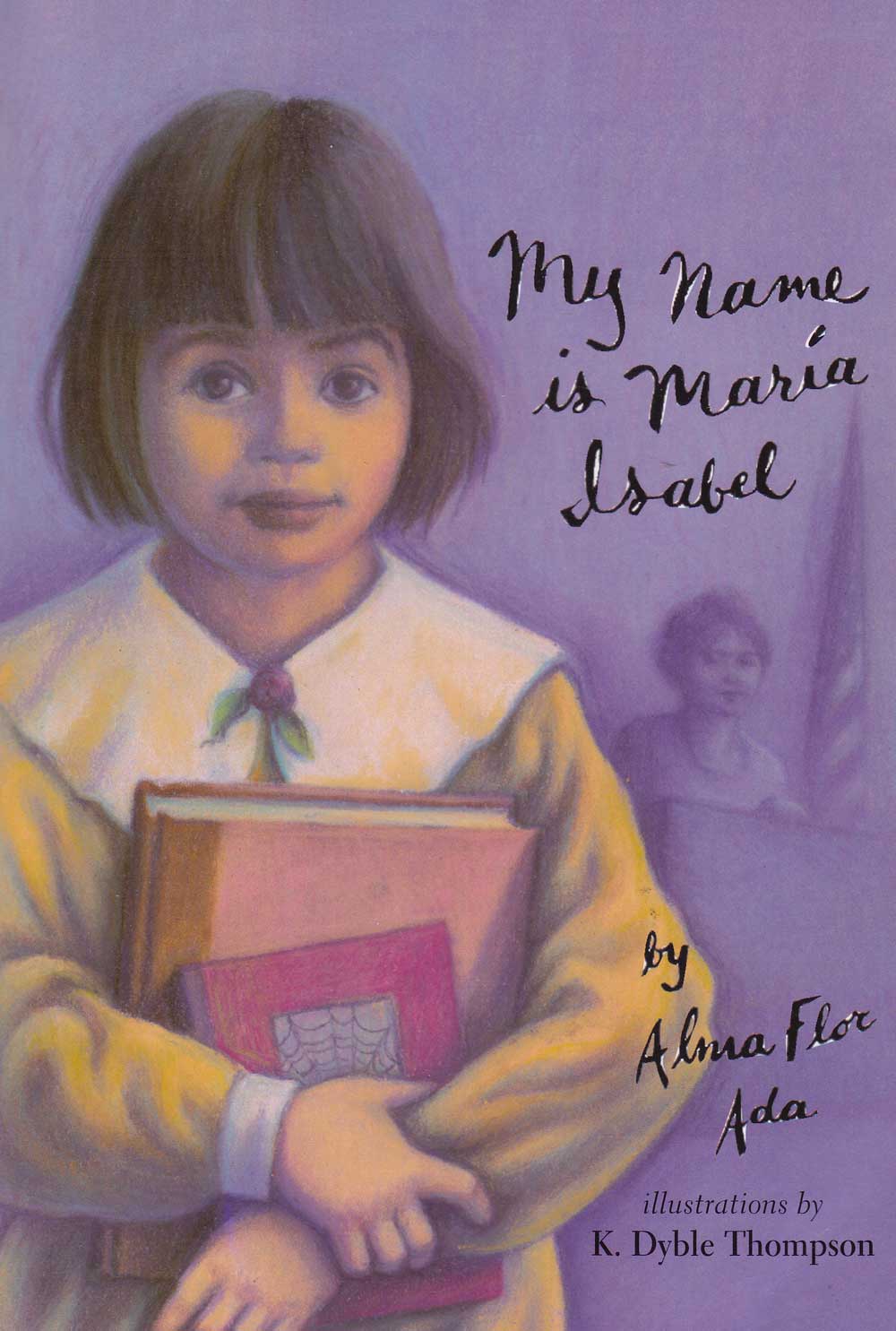 Karla Rodriguez :
This chapter book is about a little girl, Maria Isabel, who has to go through
the usual challenges of being a new student. Her biggest problem, however, is to
be called Mary Lopez by her teacher instead of the name she was born with and is
supremely proud of-Maria Isabel Salazar Sanchez. To her, this name has so much
meaning because of her grandparents and feels that it is one of the most
important aspects about her. Throughout the book she struggles to find the
courage to stand up for the way she feels and to be understood by her teacher.
I like this book because it
highlights the Hispanic culture which allows Latino students to feel empowered
but also encourages respect and acceptance of other cultures since they are
focused on as well. I also like that the book revolves around the issue of
valuing student’s names and cultures and that it helps students and teachers
to realize that these are extremely important aspects of a person that should be
respected and understood. Currently,
I am using Maria Isabel for a book club and will use it to teach literacy while
integrating social studies, math, art, and issues of social justice. Social
studies ideas: studying Puerto Rican people who have made a change in
society, learning about Puerto Rico’s relationship with the United States. Literacy
ideas:character analysis, reading comprehension strategies, learning of literary
elements, persuasive writing, text to self connections, text to text
connections. Math ideas:graphing the increase of Maria Isabel’s courage
throughout the book. Social justice ideas: exploring their own identities
(all of these students are of Hispanic culture), exploring methods of how they
can be courageous, learning and exploring other cultures, learning about the
importance of their names and culture, exploring and accepting other people’s
holidays and traditions, teaching children conflict/resolution/communication
strategies Arts ideas:creating a web of problems and how to get out of it
and performing Amahl. Ways in which it falls in the domains of sje:
1. Children of Hispanic culture are encouraged to love and accept
themselves. 2. Various cultures are represented in the book and
encourage acceptance of other’s cultures, traditions, and holidays.
3. This book deals with racism
and oppression. 4. The method in which Maria Isabel stands up for
herself is through a courage driven, detailed essay to the teacher describing
why her culture is so important and why devaluing her name and culture is like
overlooking the biggest part of her. Students will see how these small social
movements can easily be done within the classroom community. 5. This
book doesn’t directly apply to this domain. This book can easily connect
to the literacy curricular unit but not limited to the subjects that have been
mentioned above.
Karla Rodriguez :
This chapter book is about a little girl, Maria Isabel, who has to go through
the usual challenges of being a new student. Her biggest problem, however, is to
be called Mary Lopez by her teacher instead of the name she was born with and is
supremely proud of-Maria Isabel Salazar Sanchez. To her, this name has so much
meaning because of her grandparents and feels that it is one of the most
important aspects about her. Throughout the book she struggles to find the
courage to stand up for the way she feels and to be understood by her teacher.
I like this book because it
highlights the Hispanic culture which allows Latino students to feel empowered
but also encourages respect and acceptance of other cultures since they are
focused on as well. I also like that the book revolves around the issue of
valuing student’s names and cultures and that it helps students and teachers
to realize that these are extremely important aspects of a person that should be
respected and understood. Currently,
I am using Maria Isabel for a book club and will use it to teach literacy while
integrating social studies, math, art, and issues of social justice. Social
studies ideas: studying Puerto Rican people who have made a change in
society, learning about Puerto Rico’s relationship with the United States. Literacy
ideas:character analysis, reading comprehension strategies, learning of literary
elements, persuasive writing, text to self connections, text to text
connections. Math ideas:graphing the increase of Maria Isabel’s courage
throughout the book. Social justice ideas: exploring their own identities
(all of these students are of Hispanic culture), exploring methods of how they
can be courageous, learning and exploring other cultures, learning about the
importance of their names and culture, exploring and accepting other people’s
holidays and traditions, teaching children conflict/resolution/communication
strategies Arts ideas:creating a web of problems and how to get out of it
and performing Amahl. Ways in which it falls in the domains of sje:
1. Children of Hispanic culture are encouraged to love and accept
themselves. 2. Various cultures are represented in the book and
encourage acceptance of other’s cultures, traditions, and holidays.
3. This book deals with racism
and oppression. 4. The method in which Maria Isabel stands up for
herself is through a courage driven, detailed essay to the teacher describing
why her culture is so important and why devaluing her name and culture is like
overlooking the biggest part of her. Students will see how these small social
movements can easily be done within the classroom community. 5. This
book doesn’t directly apply to this domain. This book can easily connect
to the literacy curricular unit but not limited to the subjects that have been
mentioned above.
Erin : Written in Spanish, but also available in English under the title My Name is Maria Isabel, this sixty-page novel tells the story of a young girl and her struggles to adjust after moving from Puerto Rico to a school in New York that allowed students to learn in Spanish to a school in which she was expected to speak only English. Ada clearly marks this transition with a teacher who changes María Isabel's name to Mary, a distressing and confusing change for the child. Through this text, Alma Flor Ada, a native of Cuba, shares the daily life of a Puerto Rican family without preaching or prescribing. The plot is simple and uncrowded, told in the uncomplicatedly elegant language of a young girl finding her place in a new environment. I am concerned that it is set in New York, as so many books about Chicanos and Riqueños seem to be (there is even a term for Puerto Ricans in and around NYC: Nuyorican), but as this experience should resonate with many students who have lived in or visited family in New York, I am putting it in the category of generalization instead of stereotype. Overall, this is a text that I would be proud to stock in my classroom or hand to colleagues who wonder how their students from other countries feel.
Mrs Jimenez :
Discussion: I would start out saying: Class today we are going to talk about
names. Does anyone know how they got their name? I would wait for a response.
Tell class: Do you like your name? Did you know that there are different kinds
of names?
How would I teach this lesson? Class we are going to make an acrostic poem. An
acrostic poem is writing you name and writing things that symbolize you with
each letter of your first name. I have already prepared one for the class. I
will be passed around so everyone can take a look at the acrostic poem. When
everyone is finished we will discuss them. Later, today I will start reading a
book called, My name is Maria Isabel (2 chapters per day).
How would I re-teach the lesson? I would have my students’ look up their own
names in a name dictionary. Once they have written some information for their
names, as a class, we would discuss them one at a time.
 Nacer
Bailando
Nacer
Bailando
Dancing Home
A year of discoveries culminates in a performance full of surprises, as two girls find their own way to belong. Mexico may be her parents’ home, but it’s certainly not Margie’s. She has finally convinced the other kids at school she is one-hundred percent American—just like them. But when her Mexican cousin Lupe visits, the image she’s created for herself crumbles. Things aren’t easy for Lupe, either. Mexico hadn’t felt like home since her father went North to find work. Lupe’s hope of seeing him in the United States comforts her some, but learning a new language in a new school is tough. Lupe, as much as Margie, is in need of a friend. Little by little, the girls’ individual steps find the rhythm of one shared dance, and they learn what “home” really means. In the tradition of My Name is Maria Isabel—and simultaneously published in English and in Spanish—Alma Flor Ada and her son Gabriel M. Zubizarreta offer an honest story of family, friendship, and the classic immigrant experience: becoming part of something new, while straying true to who you are.
Kirkus Reviews : Two cousins, one born in Texas and the other in Mexico, learn the importanceof family and friendship. As an only child living in California with her Mexican-American parents, Margie Ceballos-González is proud to be American. Everything changes when her cousin Lupe González leaves her mother, stepfather and half-brothers in Mexico to live with Margie and her parents. Years before, Lupe’s father had moved to the United States for work and then disappeared. Margie and Lupe areboth in fifth grade at the same school, and Lupe’s presence immediately draws exactly the sort of attention Margie has been trying to avoid. At home, she finds herself competing for attention as her parents welcome Lupe with Mexican foods and Spanish conversation. Sensing her cousin’s dilemma, Lupe finds ways to help Margie appreciate their shared Mexican heritage. Margie thaws, even realizing the beauty of her name, Margarita, which came from one ofher mother’s favorite flowers, the daisy. The third-person narration shifts its focus gently from girl to girl, allowing readers access to their thoughts and feelings. The authors also connect Nicaraguan poet Rubén Darío’s“A Margarita” to the story, and the full poem follows the novel inboth Spanish and English. Although sometimes wise beyond their years, Margie and Lupe will charm readers as each girl struggles for belonging and acceptance in this realistic novel. (Fiction. 8-12)
School Library Journal : Gr 3-6–Margie is proud to be an American, born in the United States. Her parents were born in Mexico and so was her cousin, Lupe, who has come to stay with Margie’s family in California. At first Margie is excited, but that enthusiasm dissipates when Lupe is placed in her classroom. She doesn’t speak English, and Margie’s teacher expects her to translate for her. A couple of classroom bullies seem bent on belittling the cousins’ heritage. Margie is relieved when Lupe is transferred to a bilingual class, leaving a desk near her for the newest classmate, Camille. The girlsbecome great friends. When they’re given a journal assignment, Camille models what it’s like to have a passion as she thinks, researches, and writes about dolphins. Lupe stays after school to learn folkloric dances, and the book concludes with a performance that helps Margie understand how American she isand how her Mexican heritage fits into her identity. This story will assist readers in embracing their own heritage and developing an appreciation fortheir classmates’ backgrounds. It’s an enjoyable offering (and a great read-aloud) that will capture readers’ attention and have them rooting for the cousins and their friendships and family relationships. A Spanish-language edition, Nacer Bailando, is available simultaneously.
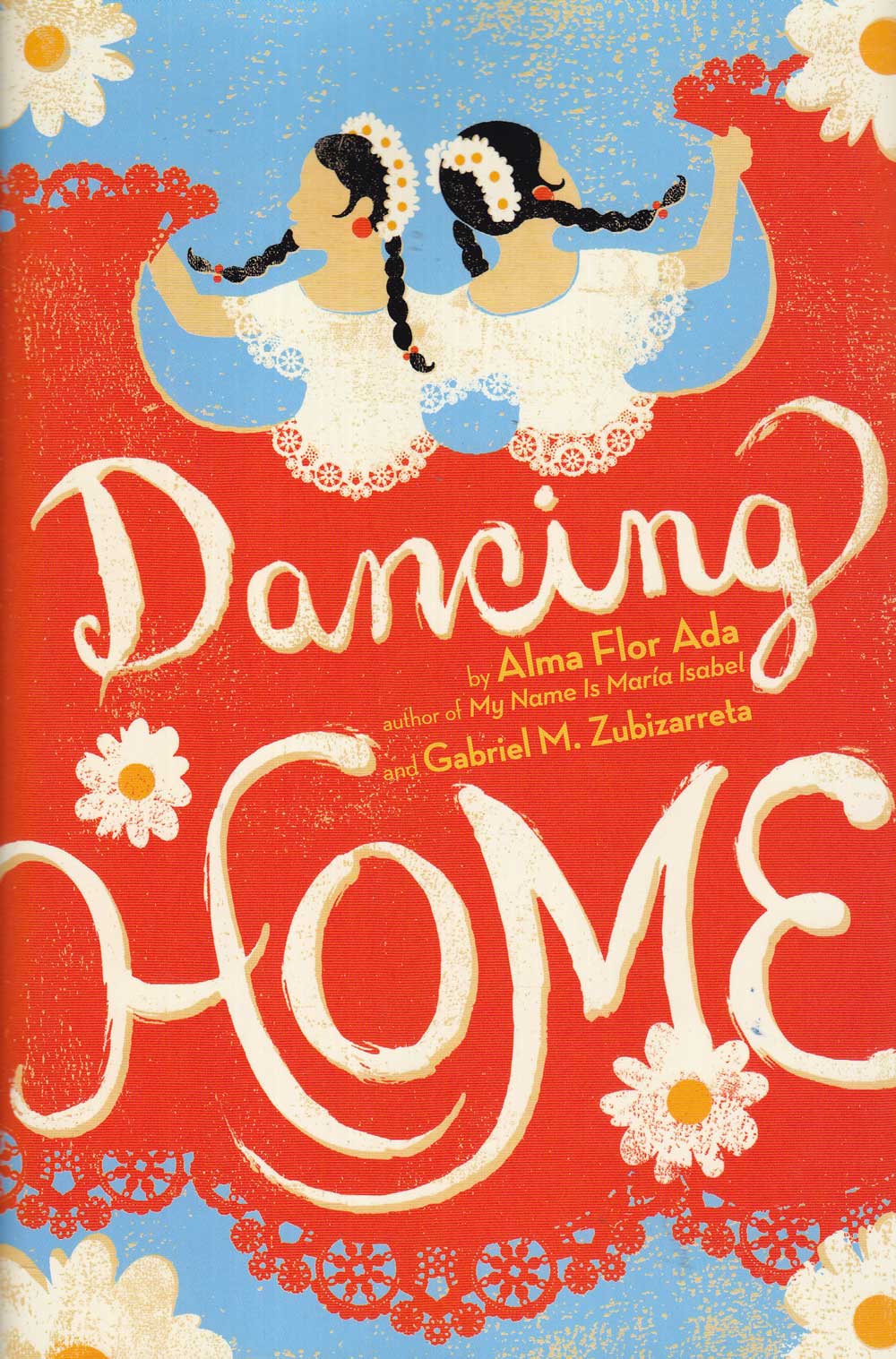 Booklist :
Ten-year-old Margie has spent her entire life trying to fit in—to pass as
anAmerican—despite the fact that her parents were born in Mexico. Then,
herMexican cousin Lupe comes to live with them, and her plan goes awry. At
first, she resents Lupe for her foreign ways and for monopolizingher parents’
attention; later, she comes to love Lupe as a sister andappreciate the Mexican
part of her heritage. Margie begins to master Spanish, enjoys celebrating
Navidad, and participates in a Cinco de Mayofolklorico dance at school. Ada, the
author of many multicultural titles,including Tales Our Abuelitas Told: A
Hispanic Folktale Collection (2006), and Zubizarreta write knowingly of the
difficulties of a life lived in two cultures. A subplot involving Lupe’s
father (who came to America illegally and later abandoned his family) is also
well handled, as is the inclusion of a Ruben Dario poem,“To Margarita.” Give
this to fans of Pam Muñoz Ryan’s Esperanza Rising (2000)and Becoming Naomi
Leon (2004).
Booklist :
Ten-year-old Margie has spent her entire life trying to fit in—to pass as
anAmerican—despite the fact that her parents were born in Mexico. Then,
herMexican cousin Lupe comes to live with them, and her plan goes awry. At
first, she resents Lupe for her foreign ways and for monopolizingher parents’
attention; later, she comes to love Lupe as a sister andappreciate the Mexican
part of her heritage. Margie begins to master Spanish, enjoys celebrating
Navidad, and participates in a Cinco de Mayofolklorico dance at school. Ada, the
author of many multicultural titles,including Tales Our Abuelitas Told: A
Hispanic Folktale Collection (2006), and Zubizarreta write knowingly of the
difficulties of a life lived in two cultures. A subplot involving Lupe’s
father (who came to America illegally and later abandoned his family) is also
well handled, as is the inclusion of a Ruben Dario poem,“To Margarita.” Give
this to fans of Pam Muñoz Ryan’s Esperanza Rising (2000)and Becoming Naomi
Leon (2004).
New York Times : Bilingualism and biculturalism are central to “Dancing Home,” by Alma Flor Ada and Gabriel M. Zubizarreta, which is being published in both English and Spanish, and tells the story of a fifth grader, Margie, Texas-born, California-reared and determined to be American at any cost. Her assimilation is challenged when her mother, Consuelo, obtains a visa for Lupe, Margie’s cousin from Mexico. Lupe, also in fifth grade, is a math whiz, but she doesn’t speak English, and everything about her embarrasses Margie, who is less than welcoming. Lupe is the daughter of Consuelo’s brother, an illegal immigrant who has disappeared. “Dancing Home” doesn’t shy from any of the harsher truths about life for Mexican immigrants: Consuelo tells Lupe that her father may be in debt to coyotes who help people cross the border illegally for a great price. His silence may be the result of his living in difficult circumstances. In the classroom, the taunts that Margie fears about immigrants are spoken without hesitation even as Ada and Zubizarreta — who are mother and son — make clear that Margie’s parents came to the United States legally and that Lupe can travel safely with a student visa. But it is the friendship between the girls and the tall, blond Camille (also a secret Latina at large) that makes this an absorbing novel for readers of any background. And the authors, for the most part, handle the narrative with tenderness and charm. As Camille tells Margie: “My father says all the time, ‘What’s important is what you learn after you already think that you know everything.’ ”
New Book Journal : In Dancing Home, two cousins, one born in Texas and the other in Mexico, learn the importance of family and friendship. As an only child living in California with her Mexican-American parents, Margie Ceballos-González is proud to be American. Everything changes when her cousin Lupe González leaves her mother, stepfather and half-brothers in Mexico to live with Margie and her parents. Years before, Lupe’s father had moved to the United States for work and then disappeared. Margie and Lupe are both in fifth grade at the same school, and Lupe’s presence immediately draws exactly the sort of attention Margie has been trying to avoid. At home, she finds herself competing for attention as her parents welcome Lupe with Mexican foods and Spanish conversation. Sensing her cousin’s dilemma, Lupe finds ways to help Margie appreciate their shared Mexican heritage. Margie thaws, even realizing the beauty of her name, Margarita, which came from one of her mother’s favorite flowers, the daisy. The third-person narration shifts its focus gently from girl to girl, allowing readers access to their thoughts and feelings. The authors also connect Nicaraguan poet Rubén Darío’s “A Margarita” to the story, and the full poem follows the novel in both Spanish and English. Although sometimes wise beyond their years, Margie and Lupe will charm readers as each girl struggles for belonging and acceptance in this realistic novel. (Fiction. 8-12)
Nacer Bailando
Reading Group Guide : http://books.
Dancing Home Reading Group Guide : http://books.
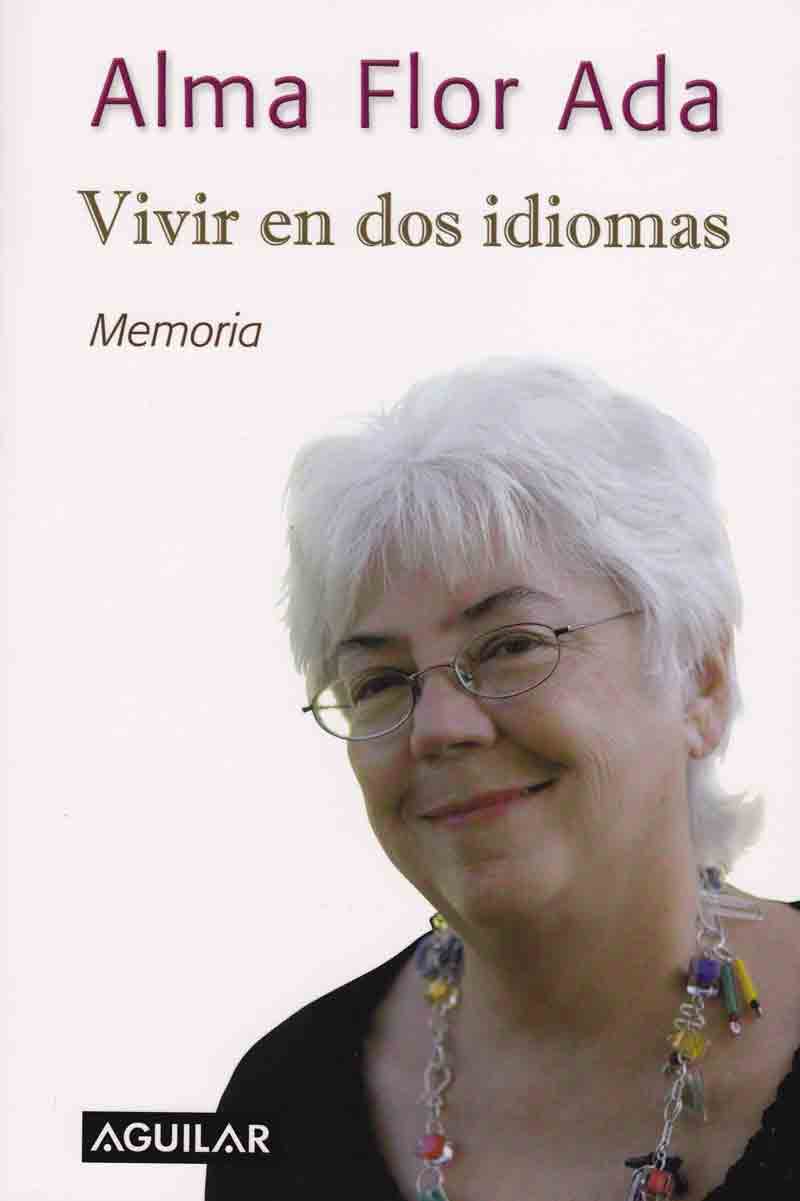 Vivir
en Dos Idiomas
Vivir
en Dos Idiomas
Readers
of Alma Flor Ada’s books and participants in her presentations have been
waiting for this book in which she tells the story of her own life.
"Vivir en dos idiomas is positioned somewhere between literature and history; it is not, however, a work of fiction.'' Using her signature style, Alma Flor Ada crafts an inspiring, intense, and personal examination of her life. This memoir presents the most significant experiences of a writer for whom narrating is synonymous with being, and an engagement that she cannot live without. From the very first pages we discover an extraordinary, gifted life. The author recounts the smallest aspects of an apparently idyllic childhood spent in Cuba -her first school years, and the first encounters with what would later become much more than inseparable companions: books. We will journey with her through ups and downs, through cities and countries in three continents. We will also witness the key incidents that led to her unflagging support of peasant immigrants in the United States. With exemplary style, Alma Flor Ada reveals the story of her career and invites us to find in books a new best friend.
''He vivido sin esperar premio ni castigo, y ahora descubro que el premio ha sido cada dÃa vivido.'' Vivir en dos idiomas se ubica en la frontera entre la literatura y la historia. Desde las primeras paginas descubrimos una vida tocada por un don. Con la sinceridad que la caracteriza, la autora hace una exploracion personal, intensa e inspiradora de su propia vida. Este libro presenta las experiencias y reflexiones mas significativas de una escritora para quien la narracion es parte del ser, un compromiso inaplazable. Con su inconfundible estilo, Alma Flor Ada nos relata los pormenores de una infancia aparentemente idiica en Cuba, sus anos de escuela y sus primeros encuentros con los libros, que mas tarde se convertirian en companeros inseparables, amigos, confidentes y portadores de su mensaje. La acompanaremos en su travesia, llena de avatares y logros, por distintos paises de tres continentes. Seremos testigos de episodios que marcarian para siempre su camino, como el contacto con maestros como Paulo Freire y las situaciones de injusticia social que motivaron su infatigable labor en pro de los campesinos inmigrantes en Estados Unidos. En estas paginas Alma Flor Ada nos ofrece, lejos de los reflectores de la figura publica, la posibilidad de ser sus companeros de viaje, mientras revela los secretos de su apasionante trayectoria.
It
was indeed a challenging process to decide what from my very long and rich life
to include in a book of memoirs, and a challenge as well to decide on the style
of the book.
The
book was started initially at the suggestion of Amaya Elezcano, a wonderful
Alfaguara editor in Madrid, Spain, who encouraged me to work on a series of
three books corresponding to different phases of my life. Later, another
talented editor from the Alfaguara group, Silvia Matute, decided to publish the
work in the Aguilar autobiographical collection as a book with three distinct
parts.
The
first section, Porque empecé a vivir [Because Life Began][G1] covers the years
from age fifteen to twenty, when I lived partly in Cuba, partly in the United
States. It explores my first experiences of living in a different country, of
trying to study and learn in another language, of awakening to the destructive
forces of racism and discrimination which could lead people to renounce their
own language and identity. The reflections brought about by these experiences
would have a lasting influence on my life. There are also more intimate
reflections about my own spiritual search.
The
style of this first part is different from the other two. Because Cuba played
such an important role in defining my experiences, I felt the need to share some
sociocultural content with the reader. To that end, each chapter is preceded by
a vignette depicting a specific geographical, social or cultural aspect of my
country that frames, or influences, the personal experiences.
The
second part of the book, La lengua se hizo matria [Language Became the
Motherland] covers the period of my life from twenty to thirty-two years of age.
During that time, I lived and studied in Madrid, Spain and in Lima, Peru, and
did postdoctoral research work at Harvard University through the Radcliffe
Institute. It was a period of great change in my life. While I insist that I
have never left Cuba, which is so much a part of me, I had to learn to live
outside of my country, and far away from everyone I knew and loved. During that
period I developed a profound love for another country, Peru, completed a
doctorate, met some extraordinary teachers, and began publishing. But above all,
during that time I began my lifelong work as a bilingual educator and the
essence of my whole being was transformed as I became a mother.
The
third part of the book covers some of the work experiences and ongoing
reflections that have made up my life of advocacy in the United States since
1970. It explores the influence that Paulo Freire has had on my life and work,
as well as what I have gained from working with farmworking families and from
the dialogic process of learning alongside my doctoral students at the
University of San Francisco and all the teachers whose classes and schools I
have been privileged to visit.
Embarking
on the introspective journey that writing a memoir requires is both difficult
and demanding. At times, one is drawn so strongly into the past that it becomes
difficult to be present in the here and now. Some of the memories are painful
and haunting and if, until now, they have been explored only superficially,
facing them may indeed be a hard task. Yet, how rewarding to be able to revisit
one's life!
A
popular Latin American song says: Recuérdame, que recordar es volver a vivir...
[Remember me, for to remember is to live again...]. And of course, that means to
live again both joys and sorrows, successes and mistakes, presences and losses.
But above all, to remember is to accept the opportunity to keep on learning from
life... and I, for one, found there is much still to learn.
Sharing
it, amidst smiles and tears, has been an act of love. It started with finding
compassion for the many persons I have been, from girlhood to adulthood, but
became above all an expression of love for all who in one way or another have
been part of the story, and for the unknown readers who may find in these pages,
I hope, an invitation to explore their own inner journeys.
But
no matter how long, rich, and diverse the experience, there is one word that
sums it up perfectly, a word that expresses the overwhelming feeling that is
left at the end of the process: gratitude.
Thanks
to life, to existence, to everyone I have encountered along the way, and to each
day.
I
have lived without expecting either punishment or reward. Now I discover the
reward has been each day I have lived!
Noticias Terra : La cuentista y educadora cubana Alma Flor Ada revela en sus memorias una vida marcada por la lectura, los viajes y los recuerdos de su patria. Aunque la prolífica escritora ya había detallado en dos libros anteriores su quehacer literario y las historias personales que dieron lugar a cuentos y poemas, en "Vivir en dos idiomas" Ada examina los eventos más significativos de su vida para un público lector adulto. Dividido en tres partes, "Vivir en dos idiomas" se lee en ocasiones como un diario de viajes, pues son muchas las culturas con las cuales Ada ha entrado en contacto, a través de sus estudios, viajes y lecturas. La primera sección, sin embargo, tiene un tono particular que la distingue de las otras dos, ya que medita sobre el contexto cultural en que creció, salpicando su relato con canciones, anécdotas y poemas. Esta parte recoge recuerdos y relatos de su querida Cuba al igual que sus primeros encuentros con la cultura estadounidense. La segunda parte, trata de su formación académica en España, Perú y EEUU y su transformación personal al hacerse madre. Y la tercera aborda su labor educativa y literaria en EEUU, donde ha residido desde 1970, y la influencia de Paulo Freire en su incansable labor social. Muy pronto en la lectura nos damos cuenta que la infancia de Ada fue privilegiada, no sólo por la soltura económica de su familia, sino por haber contado con el apoyo de sus padres para explorar intereses a menudo contrarios a las normas sociales de la época. Ada recuerda, por ejemplo, que al cumplir los quince años, sus padres le dieron la opción de pasar un verano en un campamento en el extranjero en lugar de marcar la ocasión con una fiesta, como era habitual para entonces. Lectora y estudiante voraz, Ada aprovecha la oportunidad para asistir a un colegio de niñas en Pennsylvania, donde además de aprender inglés con compañeras igualmente privilegiadas, observa por primera vez el maltrato al que eran sometidas algunas de sus compañeras por pertenecer a un grupo minoritario. El tono de "Vivir", sin embargo, no resulta pomposo, sino sincero y agradecido. Si bien resulta admirable que en su itinerante vida la escritora haya siempre obrado con tal rectitud, identificándose contra toda injusticia y logrando efectuar cambios verdaderamente asombrosos, es preciso recordar que en la lectura de autobiografía a veces se dice más en lo que queda fuera que en lo que se incluye. Las memorias literarias tienden a no diferir tanto de la buena ficción, en que nos invitan a reflexionar sobre nuestra humanidad y a llegar a nuestras propias lecciones, si es que las hay. Desafortunadamente, en más de una ocasión las memorias de Ada adolecen de didactismo. En una anécdota particularmente resonante, Ada recuerda su trabajo aun de estudiante en un orfanato de Denver. Ada y unas compañeras solían ayudar a bañar a los niños, muchos de los cuales eran hispanos, y les contaban historias en español e inglés después de terminar sus quehaceres. Un día, Ada cargaba a una niñita de tres años a quien le había tomado un cariño especial. Comenzó a contarle un cuento en inglés y la niñita la interrumpió para pedirle, en inglés, que lo hiciera "de la otra manera". Como la niña le hablaba en inglés, Ada le preguntó que por qué quería que le hablara en español. La chiquita le contestó: "Porque así se oía mi madre". Podemos imaginar el efecto que esta experiencia pudo tener en la joven Ada y deducir la importancia de la relación afectiva de los niños con la lengua materna. En este caso, como en muchos otros, la anécdota desnuda, sin comentarios o explicaciones, hubiese resultado más efectiva que seguida de un párrafo explicativo como aparece. Aún así, el libro describe la vida ejemplar de una escritora que ha dejado un importante y prolífico legado "en dos idiomas"
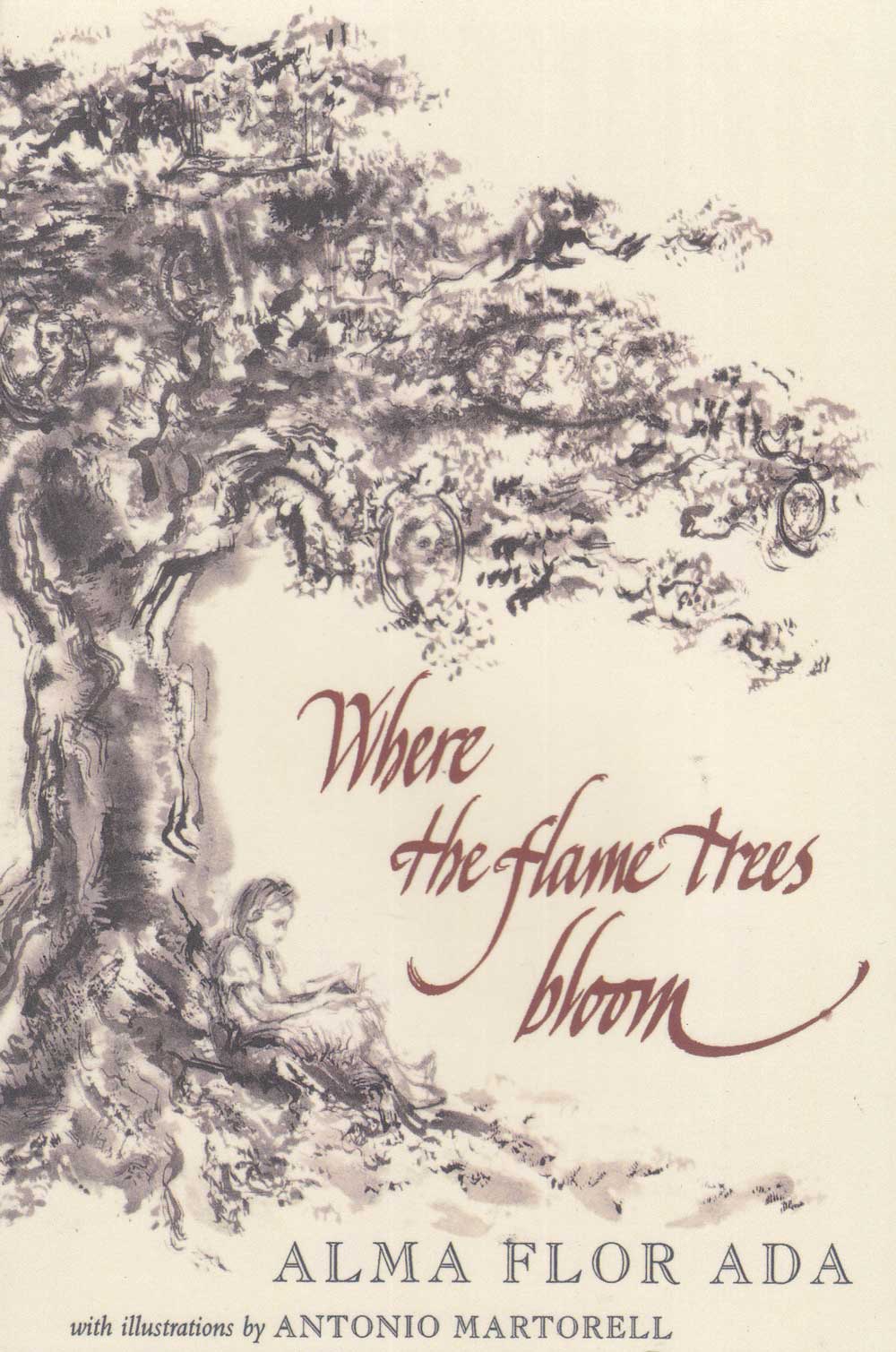 Where
the Flame Trees Bloom
Where
the Flame Trees Bloom
Where the
Flame Trees Bloom is also included in Island Treasures, along
with Under the Royal Palms
Center for Latin American Studies, America´s Commended List
Video : Colorin
Colorado Interview, Spanish
Video : Colorin
Colorado Interview, English
These true stories from Alma Flor Ada’s childhood are filled with family love and values. Told through the eyes of a child, a whole world comes to life for the reader: the blind great-grandmother who never went to school but whose wisdom and generosity overflowed to those around her; the hired hand Samoné whose love for music overcame all difficulties; her grandfather Modesto, who placed a higher value on human relationships than on his possessions. Eleven remarkable stories will move and inspire children and adults alike. Companion volume to Alma Flor Ada's "Under the Royal Palms"
School Library Journal : Grade 3-6 Those who wonder what "family values" really are may possibly find the answer in this slim volume of short stories. Telling of her childhood in Cuba, Ada begins with an introduction to her homeland followed by 11 episodes about her family and her community. One story tells of her grandfather Modesto's courage and loyalty in the face of the death of his beloved wife and the simultaneous collapse of the Cuban economy. Another tells of her great-grandmother Mina, who continued to make rag dolls for the village children even after she had lost her sight. And a third tale tells of a Japanese street vendor who sold ice cream for a living, but gave generous samples to children who could not afford to pay. Warmth and love for a treasured childhood exude from the pages. The writing is elegant, but not overly sweet. Each selection stands well on its own. Children can read this book independently or enjoy listening to it read aloud.
Listen to Vienna Rose read Where the Flame Trees Bloom to you. A marvelous example of the magical encounter between a child and books that we wish for all children. And here's an earlier reading by Vienna Rose.
 The Book Nest : The
novella is a series of vingettes, with each chapter as a titled story - I think
my favorites were "Mathematics" and "The Rag Dolls," both of
which are about her beloved great grandmother. Because of their elegant
simplicty, I think these stories could be read with pleasure to (or by) children
as young as 8 or 9, but appriciated on a different level by adults. Highly
reommended. I feel like the world is a more beautiful place, having read
this charming book. Alma Flor Ada takes us to the Cuba of her childhood, and
reading her stories, I felt like I was sitting at the feet of a beloved
Gramother, listening to her tell me of the life she knew. The stories feel that
intimate and familiar. We meet people, both relatives and friends, who show
compassion and a zest for life - from the blind great grandmother who can sew
rag dolls by touch and the hired man who plays the accordian at night. The text
was so lyrical, I truly felt like I was living amongst the trees and the
memories of those people who made Alma into the woman she is.
The Book Nest : The
novella is a series of vingettes, with each chapter as a titled story - I think
my favorites were "Mathematics" and "The Rag Dolls," both of
which are about her beloved great grandmother. Because of their elegant
simplicty, I think these stories could be read with pleasure to (or by) children
as young as 8 or 9, but appriciated on a different level by adults. Highly
reommended. I feel like the world is a more beautiful place, having read
this charming book. Alma Flor Ada takes us to the Cuba of her childhood, and
reading her stories, I felt like I was sitting at the feet of a beloved
Gramother, listening to her tell me of the life she knew. The stories feel that
intimate and familiar. We meet people, both relatives and friends, who show
compassion and a zest for life - from the blind great grandmother who can sew
rag dolls by touch and the hired man who plays the accordian at night. The text
was so lyrical, I truly felt like I was living amongst the trees and the
memories of those people who made Alma into the woman she is.
School Library Journal : Grade 3-6-Those who wonder what "family values" really are may possibly find the answer in this slim volume of short stories. Telling of her childhood in Cuba, Ada begins with an introduction to her homeland followed by 11 episodes about her family and her community. One story tells of her grandfather Modesto's courage and loyalty in the face of the death of his beloved wife and the simultaneous collapse of the Cuban economy. Another tells of her great-grandmother Mina, who continued to make rag dolls for the village children even after she had lost her sight. And a third tale tells of a Japanese street vendor who sold ice cream for a living, but gave generous samples to children who could not afford to pay. Warmth and love for a treasured childhood exude from the pages. The writing is elegant, but not overly sweet. Each selection stands well on its own. Children can read this book independently or enjoy listening to it read aloud.
Where the Flame Trees Bloom, by Alma Flor Ada, is a lovely memoir of growing up in Cuba. A second volume is called Under the Royal Palms. She wrote these books for young people as a series of vignettes that tell about her family, her town, and her experiences growing up on the outskirts of a Cuban town called Camagüey. "My grandmother and one of my uncles were great storytellers. And every night, at bedtime, my father told me stories he invented to explain to me all that he knew about the history of the world. With all these storytellers around me, it is not a surprise that I like to tell stories." And the stories she shares are beautifully told. The very first story in Where the Flame Trees Bloom is my favorite, although I enjoyed each one. It is called "The Teacher," and recounts a poignant experience in the life of her grandmother. In the telling of this story, she captures a spontaneous teaching moment that reveals the heart of the teacher (her grandmother) and the ultimate purpose of teaching. I was very moved by this story and the way she told it. Here's an excerpt from it that was printed on the back cover of the book : "Look," continued my grandmother, as she pointed to the road that bordered the farm. There the students saw a solitary man walking. "Look at that old man. He is walking by us. In a few minutes he will be gone forever, and we will never have known who he is, where he is going, what may be important in his life." The students watched the man, who by then was quite close. He was very thin and a coarse guayabera hung loosely over his bent frame. His face, in the shade of a straw hat, was weathered and wrinkled. "Well," said my grandmother, "do we let him go away, forever unknown, or do you want to ask him if there is anything we can do for him?" These beautifully written little books would be a lovely way to introduce young people to the genre of memoirs. Both books are well worth reading for adults as well as for children.
 Si
somos Latinos
Si
somos Latinos
Yes
We Are Latinos
Juanita lives in New York and is Mexican. Felipe lives in Chicago and is Panamanian, Venezuelan, and black. Michiko lives in Los Angeles and is Peruvian and Japanese. Each of them is also Latino. Thirteen young Latinos and Latinas living in America are introduced in this book celebrating the rich diversity of the Latino and Latina experience in the United States. Free-verse fictional narratives from the perspective of each youth provide specific stories and circumstances for the reader to better understand the Latino people’s quest for identity. Each profile is followed by nonfiction prose that further clarifies the character’s background and history, touching upon important events in the history of the Latino American people, such as the Spanish Civil War, immigration to the US, and the internment of Latinos with Japanese ancestry during World War II. Alma Flor Ada and F. Isabel Campoy’s informational yet heartwarming text provides a resource for young Latino readers to see themselves, while also encouraging non-Latino children to understand the breadth and depth of the contributions made by Latinos in the US. Caldecott Medalist David Diaz’s hand-cut illustrations are bold and striking, perfectly complementing the vibrant stories in the book. YES! WE ARE LATINOS stands alone in its presentation of the broad spectrum of Latino culture and will appeal to readers of fiction and nonfiction.
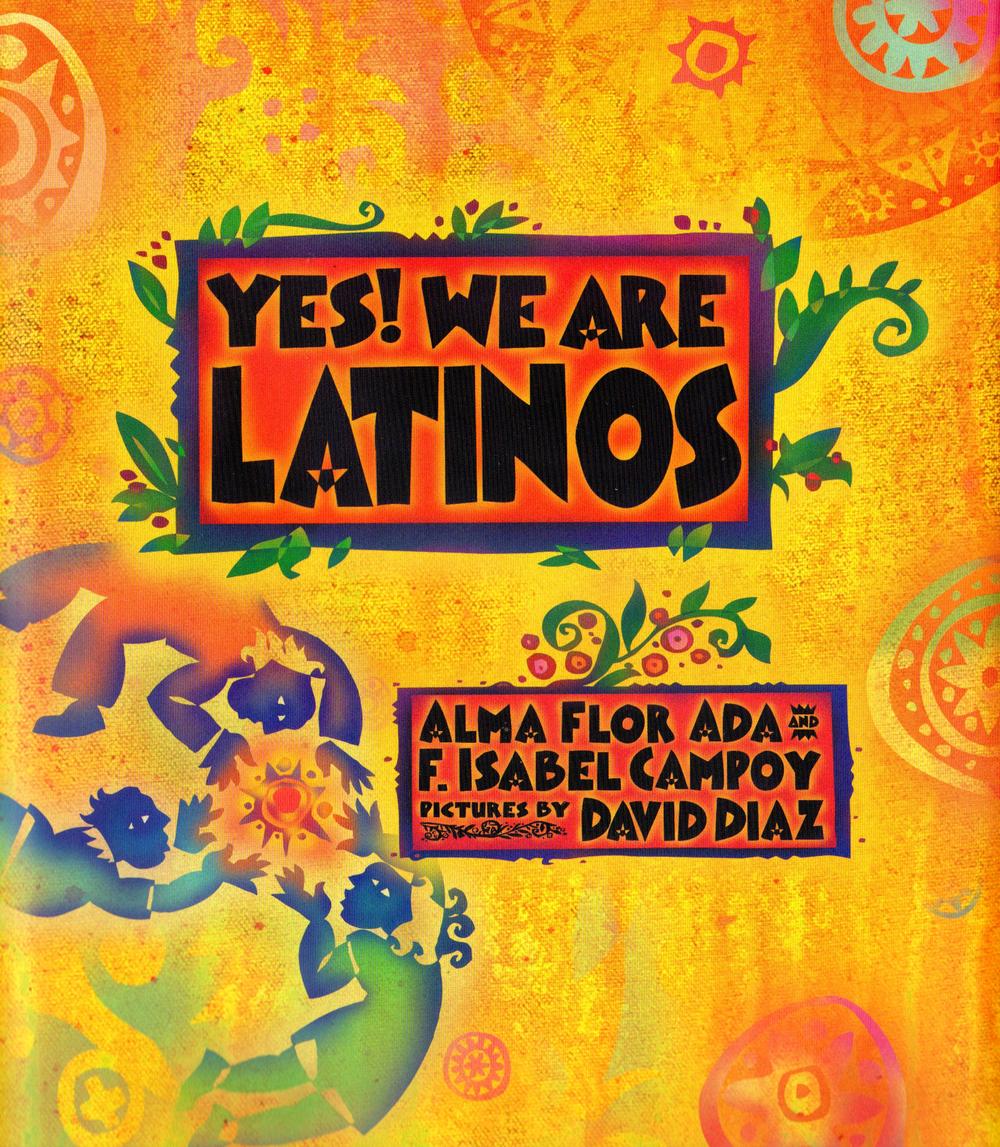 School Library
Journal : Gr 4-8–A collection of narrative poems meant to represent
young Latinos of diverse and multiple backgrounds. All of the selections start
with the statement, “My name is…,” followed by a bit about where the
narrators live, how they came to the United States, and how their families'
cultural identities are shaping their future. Each entry is followed with
another short narrative that includes historical references to contextualize the
“child's” story. It is refreshing to see a varied presentation that includes
those from different ethnic, racial, and religious backgrounds, in addition to
representing some of the smaller Latin American countries and the islands in the
Caribbean. The vignettes also help to illustrate the meaning of being mestizo–the
blending of indigenous, African, and Spanish lineage–mentioned in the
introduction and explored throughout. Another notable detail is the inclusion of
Asians in Latin America, which is often overlooked in children's literature. The
illustrations are interesting lino cutouts, black and white, reminiscent of
Latino folk art, akin to wood carvings and papel picado. Teachers looking for a
starting point to write personal narratives will find the book extremely useful
as will those seeking to recognize and highlight this diverse population.
School Library
Journal : Gr 4-8–A collection of narrative poems meant to represent
young Latinos of diverse and multiple backgrounds. All of the selections start
with the statement, “My name is…,” followed by a bit about where the
narrators live, how they came to the United States, and how their families'
cultural identities are shaping their future. Each entry is followed with
another short narrative that includes historical references to contextualize the
“child's” story. It is refreshing to see a varied presentation that includes
those from different ethnic, racial, and religious backgrounds, in addition to
representing some of the smaller Latin American countries and the islands in the
Caribbean. The vignettes also help to illustrate the meaning of being mestizo–the
blending of indigenous, African, and Spanish lineage–mentioned in the
introduction and explored throughout. Another notable detail is the inclusion of
Asians in Latin America, which is often overlooked in children's literature. The
illustrations are interesting lino cutouts, black and white, reminiscent of
Latino folk art, akin to wood carvings and papel picado. Teachers looking for a
starting point to write personal narratives will find the book extremely useful
as will those seeking to recognize and highlight this diverse population.
Booklist : This book celebrates the amazing and underappreciated diversity of the Latino community and makes great strides toward ameliorating one-dimensional stereotypes. Through 12 narrative poems, the authors explore the experiences of fictional men and women; Christians and Jews; immigrants, indigenous people, and second-generation Americans; professionals and farmers; all of whom identify themselves as Latinos. Each poem is followed by brief factual explanation of the major themes within, such as the Spanish Civil War, Asian influences in Latin America, and Cuba’s relationship with the U.S. Black-and-white abstract art by Caldecott winner Díaz elevates each individual’s story by illustrating major themes. While the authors include a bibliography of source material, they also acknowledge a lengthy list of people who provided inspiration for the topics discussed in the book. Perhaps it is the use of these real-life figures that gives the fictional vignettes such an air of realism and relatability for both Latino and non-Latino readers alike. Grades 3-6.
To Order or to Ask
a Del Sol Question, read the Del
Sol Order Info and then email Rey Del Sol
![]()
333 N Main Street, # 2464, Cedar
City, UT, 84720
